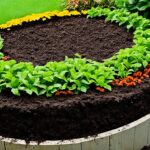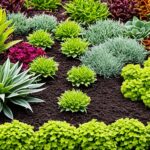Soil Health
The Benefits of Mulching and How to Apply It Correctly
Have you ever thought about the power of mulch? It’s more than just pretty to look at. Mulch can change your garden for the better, making it more beautiful and productive. We’ll show you how mulching can help with weed control, keep soil moist, and boost your garden’s health and look.
Get ready to see the magic of mulching and learn how to use it right for the best results.
Key Takeaways
- Mulching reduces weed growth, keeping your garden neat and tidy.
- Mulch helps retain soil moisture, reducing the need for frequent watering.
- Applying mulch regulates soil temperature, protecting plant roots from extreme heat or cold.
- Mulching improves soil structure and overall health, supporting the growth of healthy plants.
- Mulch can enhance the curb appeal of your outdoor spaces, adding a finishing touch of elegance.
But did you know the right way to apply mulch is key to its benefits? Learn the best techniques to make your garden flourish with mulching. Find out more in the next sections and turn your outdoor space into a beautiful, sustainable oasis.
What is Mulching?
Mulching is a way to protect soil by adding a layer of material on top. This layer, called mulch, comes from different sources. Organic mulch materials like wood chips and leaves help soil health as they break down. Inorganic mulch such as gravel lasts longer and needs less upkeep.
Definition and Types of Mulch
Mulch is any material spread on soil to protect it. It helps control weeds and keeps soil moist. Knowing the types of mulch helps pick the best one for your garden.
There are two main kinds of mulch:
- Organic mulch: Comes from things like wood chips and leaves. These materials add nutrients to the soil as they decompose.
- Inorganic mulch: Includes materials like gravel and rubber. These types of mulch last a long time and are easy to care for.
Choosing between organic and inorganic mulch depends on your garden’s needs and your preferences. Knowing the differences between types of mulch helps you make the right choice for your garden.
Mulching Reduces Weed Growth
Mulching is great for stopping weeds in your garden. It puts a barrier that blocks sunlight and smothers weed seeds. This means you spend less time pulling weeds and can enjoy gardening more.
Keeping a 2-4 inch layer of mulch helps keep weeds away and helps your plants grow well. It acts as a weed barrier, stopping weed seeds from getting the sunlight and warmth they need. This stops weed germination and cuts down on weeds in your garden.
Mulch also stops weed roots from getting through, making it hard for weeds to survive. This mix of physical and environmental barriers makes mulching a strong way to keep your garden weed-free.
“Mulching is one of the most effective ways to control weeds in a garden. The layer of mulch blocks sunlight and smothers weed seeds, preventing them from germinating.”
Adding mulching to your gardening routine cuts down on the work needed for weed control. You get a beautiful, easy-to-maintain garden with less effort.
Moisture Retention and Water Conservation
Water conservation is key for a lush, vibrant garden. Mulch is a great tool for this. It covers the soil, reducing evaporation and keeping moisture in the soil longer. This means you water your plants less often, saving time, money, and resources.
The type of mulch you use matters for water saving. Coarser mulches like wood chips or pine bark let water soak into the soil easily. Finer mulches, such as shredded leaves or compost, create a barrier that stops water from running off. Choosing the right mulch can make your garden more water-efficient and keep your plants healthy.
How Mulch Helps Retain Soil Moisture
Mulch acts as a shield, protecting the soil from the sun and wind. This slows down evaporation, keeping moisture in the soil for your plants. With higher soil moisture, you water less often, saving water and supporting drought-tolerant gardening.
| Mulch Type | Water Penetration | Evaporation Reduction |
|---|---|---|
| Coarse (Wood Chips, Pine Bark) | High | Moderate |
| Fine (Shredded Leaves, Compost) | Moderate | High |
Adding mulch to your garden can change the game for water use. By picking the right mulch and applying it right, you get a lush garden with less water use. This also helps your soil stay healthy over time.
“Mulch is a gardener’s secret weapon for water conservation. It’s a simple, yet highly effective way to keep your plants hydrated and your water bills low.”
Regulates Soil Temperature
Mulch is a key tool for keeping your soil at the right temperature. It acts like insulation, keeping the soil at a good temperature for your plants all year.
In summer, mulch keeps the soil cool, protecting your plants’ roots from the heat. This is especially important for young plants that can’t handle big temperature changes.
In winter, mulch keeps the soil warm, protecting your plants from frost. It stops sudden drops in temperature, keeping your plants’ roots safe and warm.
Mulch makes a great environment for your plants to grow. It helps with root growth and keeps your plants healthy. Mulch is a big help in keeping your soil temperature right, whether it’s hot or cold.
“Mulch is like a cozy blanket for your soil, protecting it from the harsh extremes of nature.”
Mulch keeps the soil temperature steady, helping your plants grow strong. This is key for gardening success. A layer of mulch can really improve your plants’ health and growth.
Improves Soil Health and Structure
Choosing organic mulches like wood chips or leaves does more than make your garden look good. It also boosts the health and structure of your soil. As these mulches decompose over time, they add important soil organic matter. This is key for soil fertility.
This process helps the soil microbiome grow. This includes microorganisms and earthworms that are crucial for nutrient cycling and soil structure.
The decomposing mulch also makes the soil better for water and roots. It helps plants grow strong and healthy. By using mulch, you’re making your garden’s soil healthier and more productive over time.
| Benefits of Mulching for Soil Health | Impact |
|---|---|
| Increases soil organic matter | Enhances soil fertility and structure |
| Encourages beneficial soil microorganisms | Improves nutrient cycling and soil aggregation |
| Promotes better water infiltration and root penetration | Supports overall plant health and growth |
Adding mulch to your garden does more than make it look nice. It’s a way to invest in your soil’s health and productivity. This simple step can change your garden, making it a place for healthy plants and a beautiful outdoor space.
“Healthy soil is the foundation for productive, sustainable agriculture.” – USDA Natural Resources Conservation Service
Prevents Erosion and Compaction
Mulching is key to a healthy garden. It fights the bad effects of soil erosion and soil compaction. Mulch covers the soil, protecting it from wind, rain, and foot traffic.
Mulch absorbs raindrops, slowing down water runoff. This lets the soil soak up moisture better. It lowers the chance of soil erosion and keeps the soil’s structure right, stopping it from getting hard and compacted.
In busy spots, mulch is a must for protecting soil structure. It acts as a shock absorber, stopping the soil from getting packed down by people or machines. This helps roots grow strong and plants stay healthy, making your garden better.
Adding mulch to your garden is a smart move for its long-term health and productivity. It keeps your soil safe from erosion and compaction. This means your garden will stay lively and support your plants for many years.
Learn more about mulching and how it keeps your soil fertile and safe.
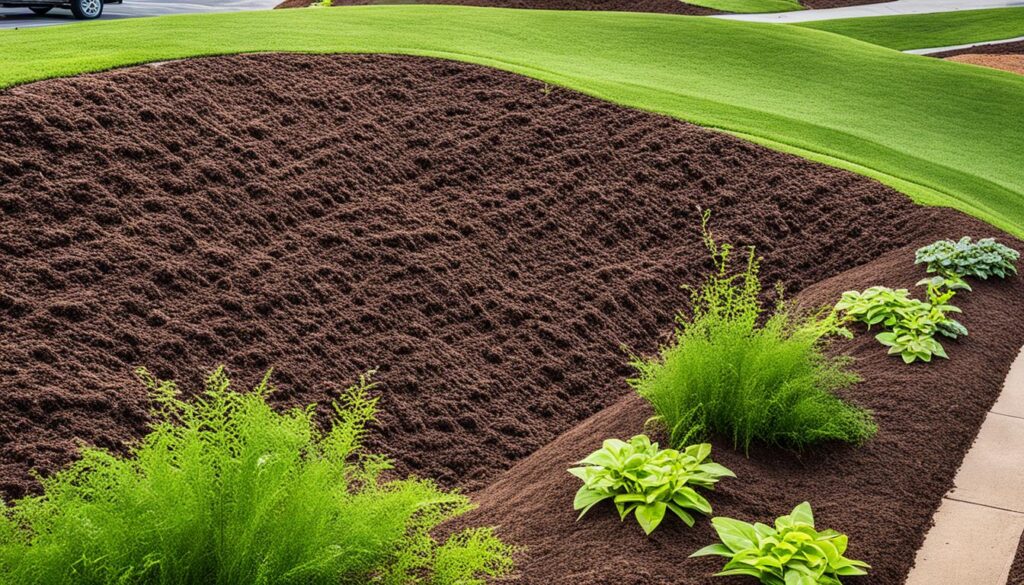
“Mulch is a garden’s best friend, shielding soil from the elements and nurturing its structure for healthier, more vigorous plants.”
| Benefit | Impact |
|---|---|
| Prevents Soil Erosion | Mulch acts as a protective layer, absorbing the impact of raindrops and slowing down water runoff, allowing the soil to absorb moisture more effectively. |
| Combats Soil Compaction | The mulch cushions the soil surface, preventing it from becoming hard-packed and compacted, especially in high-traffic areas. |
| Maintains Soil Structure | By preserving the soil’s porous structure, mulch supports healthy root growth and overall plant vigor. |
Enhances Curb Appeal
Mulching is more than just a garden solution; it boosts your outdoor spaces’ aesthetic appeal. The color and texture of mulch make garden beds, pathways, and plantings look better. It gives them a polished, professional look. Colored mulches, like red or black, match your home’s colors and garden plants.
Mulch is a finishing touch for your landscape design. It makes your property look well-kept and inviting. This is great if you’re selling your home, as a nice exterior makes a good first impression on buyers.
Adding mulch to your landscape design is a smart move. It makes your outdoor space look better and can increase your property’s value. Mulch helps create a aesthetically pleasing look that highlights your property’s best features.
“Mulch is the unsung hero of the garden – it quietly enhances the aesthetic appeal of your outdoor spaces while also providing a host of practical benefits.”
mulching Techniques
Proper mulch application is crucial for your garden’s success. By following simple steps, you can help your plants flourish and keep your landscape looking great.
Preparing the Soil for Mulch
Start by clearing the area of weeds, debris, or dead plants. This makes a clean space for the mulch to work well. Then, water the soil well so it absorbs the moisture fully.
This step helps the mulch last longer and work better.
Applying the Mulch
With the soil prepared, it’s time to add mulch. Aim for a depth of 2-4 inches, but don’t let it touch plant stems or trunks. Spread it evenly, making a doughnut shape around each plant for air and water flow.
Don’t pile mulch too high to avoid pest or disease problems. Keep the layer at the right depth and add more as needed.
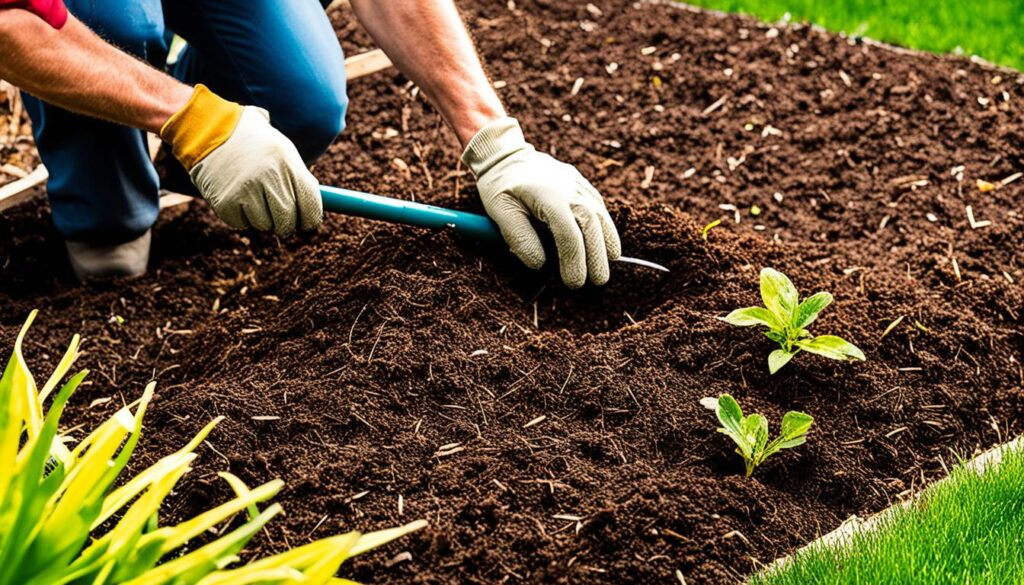
“Proper mulch application is the key to unlocking the full benefits of this garden essential.”
By following these best practices for mulch application, mulch depth, soil preparation, and mulch coverage, you’ll make your mulching efforts more effective. This supports your garden’s health and beauty.
Conclusion
Mulching changes your outdoor areas into lush, easy-to-care-for spots. It makes your garden healthier and more beautiful. By using mulch, you can fight weeds, keep soil moist, control temperature, improve soil, and stop erosion.
Choosing between organic or inorganic mulch is important. It’s all about using it right and picking the best type for your garden. Mulching can take your gardening to the next level, making it more sustainable.
Start using mulching to make your garden thrive with less work. Begin your journey to a sustainable garden. Enjoy a beautiful outdoor space that connects you with nature and boosts your pride in your home.
FAQ
What is mulching and what are the different types of mulch materials?
Mulching is adding a protective layer on top of your garden soil. This layer is called mulch. It can be organic (like wood chips or leaves) or inorganic (like gravel or rubber). Organic mulches improve soil health as they break down. Inorganic mulches last longer and need less upkeep.
How does mulching help reduce weed growth?
Mulch acts as a barrier, blocking sunlight and weed seeds. This stops weeds from growing. You’ll spend less time pulling weeds, letting you enjoy gardening more.
How does mulch help retain soil moisture and conserve water?
Mulch covers the soil, reducing evaporation. This keeps soil moist longer. You’ll water your plants less, saving time, money, and resources.
How does mulch regulate soil temperature?
Mulch insulates the soil, keeping it cool in summer and warm in winter. It protects roots from heat and frost damage.
How does mulch improve soil health and structure?
Organic mulches like wood chips add nutrients and matter to the soil as they break down. This makes the soil richer and improves its structure and health.
How does mulch prevent erosion and soil compaction?
Mulch protects soil from wind, rain, and foot traffic damage. It cushions the soil, preventing erosion and compaction. This supports healthy root growth and plant health.
How can mulching enhance the aesthetic appeal of a garden?
Mulch’s rich color and texture improve garden beds and pathways. It gives your landscape a polished look, making it inviting and well-maintained.
How do you properly apply mulch in the garden?
Clear the area of weeds and debris, then water the soil well. Put down a 2-4 inch layer of mulch, avoiding plant stems. Spread it evenly, leaving space around plants for air and water. Add more mulch as needed to keep it at the right depth.
Source Links
- https://www.homedepot.com/c/ai/benefits-of-mulch/9ba683603be9fa5395fab901dfafd55 – Benefits of Mulch
- https://scotts.com/en-us/lawn-care-101/the-benefits-of-mulching-how-to-pick-the-right-type-of-mulch-material.html – The Benefits of Mulching & How to Pick the Right Type of Mulch Material
- https://homesteadersofamerica.com/8-benefits-of-mulch-in-the-garden/ – 8 Benefits of Mulch in the Garden – Homesteaders of America
No-Dig Gardening: Benefits and How to Start
Imagine a garden that grows easily, with few weeds, and full of life. This dream is what no-dig gardening is all about. It’s changing how we garden. We’ll look at its benefits and how to begin your own easy garden.
But first, let’s ask a big question: What if the secret to a great garden is working with nature, not against it? This idea is at the heart of no-dig gardening. It’s a new way of gardening that turns old ideas upside down.
Key Takeaways
- No-dig gardening is a sustainable way to improve soil without turning it over.
- This method cuts down on work, weeds, and helps plants grow healthier naturally.
- It works like nature’s ecosystem, making gardens easy to care for and full of life.
- Using no-dig gardening can make your soil better and healthier.
- Starting with no-dig gardening, like sheet mulching, can turn your yard into a green oasis.
Embracing Nature’s Ecosystem: The Principles of No-Dig Gardening
No-dig gardening is all about understanding the soil ecosystem. It’s full of life, from fungi to earthworms and beneficial microbes. By copying nature, gardeners make their soil better and grow strong, healthy gardens.
Soil is Life: Understanding the Soil Ecosystem
Soil is alive, not just a simple ground cover. It’s a complex mix of organisms that help plants grow. These include bacteria, fungi, and microbes that are key to nutrient cycling and keeping the soil healthy. No-dig gardening helps keep this ecosystem strong, giving plants the nutrients they need.
Mimicking Nature: The Art of No-Dig Gardening
No-dig gardening follows nature’s lead. It lets organic matter break down naturally, enriching the soil. This way, the soil stays healthy and plants grow better. By not tilling the soil, gardeners keep the soil’s life and networks that plants need to thrive.
“The soil is the great connector of our lives, the source and destination of all.” – Wendell Berry
Using no-dig gardening lets you improve your soil and grow a beautiful, organic garden. This method is good for the soil and helps you connect more with the earth.
Transforming Your Garden: The Sheet Mulching Technique
Starting with no-dig gardening means using the sheet mulching technique, also known as lasagna gardening. This method layers organic materials on top of your soil or lawn. It creates a perfect environment for plants to grow well.
Layering Organic Materials: The Lasagna Gardening Approach
Sheet mulching’s success comes from layering organic materials carefully. Start with cardboard or newspaper to block light and stop weeds. Then, add a thick layer of compost for nutrients and organic matter.
Keep adding layers of organic matter, like shredded leaves, straw, or aged manure. This creates a rich environment for your plants.
Compost: The Key to a Thriving No-Dig Garden
- Compost is crucial for a no-dig garden, bringing beneficial microorganisms and improving soil structure.
- Adding compost to your layers boosts the soil’s moisture retention and nutrient cycling.
- As the organic materials break down, they increase the soil’s organic matter. This makes the soil more fertile and healthy.
“The beauty of sheet mulching is that it allows you to transform even the most challenging soil into a thriving, nutrient-rich garden bed, without the need for arduous digging or tilling.”
The Bounty of No-Dig Gardening: Reduced Weeds and Healthier Plants
No-dig gardening can change your garden for the better. It leads to fewer weeds and healthier plants. By putting a thick, rich mulch on the soil, you stop weeds from growing.
Using cardboard or newspaper helps block light, so weed seeds can’t grow. The compost adds nutrients that help your plants thrive. As your plants grow, they crowd out weeds, making the soil less welcoming for them.
This means your garden will have healthier plants, fewer weeds, and richer soil. No-dig gardening lets you focus on your plants, not fighting weeds. It’s a way to take back your garden.
| Benefits of No-Dig Gardening | Traditional Tilling | No-Dig Approach |
|---|---|---|
| Weed Suppression | Frequent manual removal required | Thick mulch layer smothers weeds |
| Soil Fertility | Disrupts soil structure, depletes nutrients | Compost and organic matter enrich the soil |
| Plant Health | Vulnerable to pests and diseases | Thriving root systems and microbial communities |
Try no-dig gardening and see how your garden changes. You’ll have fewer weeds, healthier plants, and soil full of life. This sustainable method brings big rewards.
Unleashing Nature’s Power: The Ecosystem Engineers at Work
No-dig gardening thrives thanks to the many creatures in the soil ecosystem. These heroes, like worms, insects, and microbes, work hard to keep your garden’s soil healthy.
The Unsung Heroes: Worms, Insects, and Microbes
Worms are key “ecosystem engineers.” They dig tunnels, letting air and water deep into the soil. Their waste, or castings, adds nutrients and improves soil.
Insects, like beetles and ants, are vital too. They break down organic matter and release nutrients for plants. Many insects also eat pests, keeping your garden balanced.
Underground, microbes like bacteria and fungi are busy. They turn organic stuff into nutrients for plants. They also help soil structure and support beneficial fungi that help plants grow.
| Organism | Role in the Soil Ecosystem |
|---|---|
| Worms | Aerate soil, improve structure, and provide nutrient-rich castings |
| Insects | Decompose organic matter, prey on pests, and maintain balance |
| Microbes | Break down organic materials, release nutrients, and improve soil structure |
Supporting these “ecosystem engineers” makes your no-dig garden thrive. It becomes a self-sustaining system that gives you lots of healthy, nutrient-rich food.
No-Dig Gardening: A Sustainable Solution for Thriving Gardens
Embracing sustainable gardening, no-dig gardening is an eco-friendly way to grow gardens. It reduces soil disturbance and uses natural processes. This method helps with carbon sequestration and climate change mitigation. It also makes gardens more fertile and resilient to drought and extreme weather.
No-dig gardening sees soil as a living ecosystem full of microorganisms, insects, and worms. By keeping this balance, gardeners create a self-sustaining garden. This method needs less fertilizers and pesticides, helping plants and the environment.
- Reduced carbon footprint: No-dig gardening cuts down soil disturbance, which traps carbon in the soil and fights climate change.
- Improved soil health: It boosts the soil’s natural fertility, making it better at holding water and providing nutrients for plants.
- Increased biodiversity: The undisturbed soil is a great home for beneficial organisms, creating a balanced garden ecosystem.
No-dig gardening is a sustainable way to make gardens lush, productive, and good for the environment. By using this method, you help your soil, plants, and the planet.
“Sustainable gardening is not just about growing food or flowers – it’s about nurturing the entire ecosystem and leaving the land in a better state than we found it.”
| Benefits of No-Dig Gardening | Traditional Gardening |
|---|---|
| Improved soil structure and fertility | Soil degradation and loss of organic matter |
| Increased water-holding capacity and drought resilience | Higher irrigation and water usage |
| Enhanced biodiversity and ecosystem balance | Disruption of natural habitats and reduced biodiversity |
| Lower carbon footprint and climate change mitigation | Higher carbon emissions and contribution to climate change |
Nurturing the Soil, Nurturing Yourself: The Mental and Physical Benefits
No-dig gardening offers more than just practical benefits. It can deeply affect your mental and physical health. Caring for a garden can make you feel closer to nature. It encourages mindfulness and stress relief. Plus, it’s a great way to get some exercise.
Gardening is good for your mental health. Digging, planting, and weeding can make you focus on the now. This helps reduce anxiety and makes you feel happier.
Gardening also boosts your physical health. The exercise and sunlight can improve your heart health, muscle strength, and flexibility. Eating fresh produce from your garden can make your diet more varied and tasty. This supports your overall well-being.
“Gardening is the purest of human pleasures.” – Francis Bacon
Choosing no-dig gardening helps you grow a beautiful garden and a strong connection to nature. Taking care of the soil helps your mental and physical health. It makes gardening a rewarding and refreshing activity.
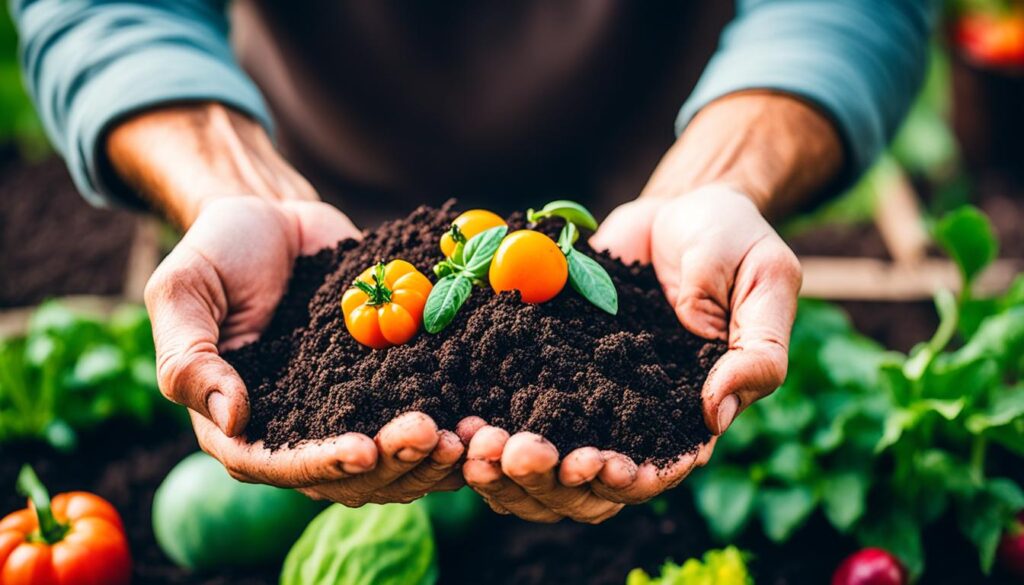
no-dig gardening: A Low-Maintenance Approach to Gardening Bliss
Embracing no-dig gardening means saying goodbye to hard gardening tasks. This new way of gardening saves your time and energy. It lets you enjoy the best parts of gardening.
No-dig gardening is easy to keep up with. You don’t need to till, weed, or lift heavy things often. This makes your garden a beautiful place with little work needed to keep it looking great. The mulch stops weeds, and the soil works hard on its own, needing almost no help from you.
| Benefits of No-Dig Gardening | Traditional Gardening |
|---|---|
| Reduced effort and time investment | Constant weeding, tilling, and manual labor |
| Healthy, nutrient-rich soil | Depleted, compacted soil |
| Thriving, low-maintenance plants | Struggling, high-maintenance plants |
Join the effortless gardening movement and find the real bliss of a low-maintenance, time-saving garden. Start with no-dig gardening and turn your outdoor area into a lush, lively space with little work.
“No-dig gardening is the ultimate in low-maintenance and reduced effort gardening. It’s a true time-saving and effortless way to create a thriving, productive garden.”
Seasonal Transitions: Adapting No-Dig Gardening to Your Climate
No-dig gardening works well in many climates. As seasons change, simple tweaks can keep your garden thriving all year. Whether you’re getting ready for spring or enjoying summer’s harvest, these tips will help your no-dig garden flourish.
Spring Awakening: Preparing Your No-Dig Garden
When spring comes, wake up your garden gently. Start by adding compost to your beds to make the soil rich and ready for new growth. Watch out for any frost in your area and protect your seedlings. With some prep work, your garden will be ready for a great spring harvest.
Summer Abundance: Reaping the Rewards of No-Dig Gardening
Summer is a time to celebrate in your no-dig garden. The organic layers you built up will help keep the soil moist and weed-free. This lets you enjoy your garden’s bounty without much work, enjoying the harvests your garden provides.
No matter the season, no-dig gardening is a sustainable way to grow your dream garden. By using seasonal adaptations and climate-specific techniques, your no-dig beds will do well from spring preparation to summer harvests.
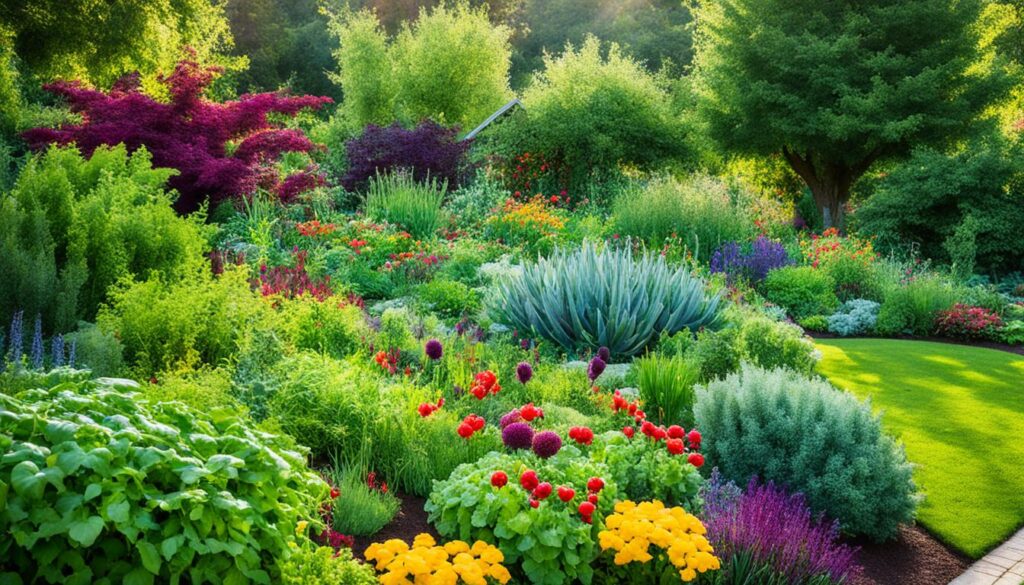
Conclusion: Embracing a New Gardening Philosophy
No-dig gardening changes how you grow food and plants. It means working with nature instead of fighting it. This way, you get gardens that are healthy, easy to care for, and good for the planet.
This method makes you connect more with nature and live more sustainably. It leads to lots of food and a stronger bond with the earth. It’s a new way of gardening that’s good for you and the planet.
Switching to no-dig gardening means using practices that help the soil’s ecosystem. You’ll see your garden do well without needing a lot of work. This approach makes you a caretaker of the earth, enjoying the mental and physical perks of a beautiful garden.
Starting with no-dig gardening is a journey of learning and wonder. You’ll see how nature’s design is beautiful and strong. By going this way, you’ll change your garden and gain a new respect for all living things. Start this path and see the amazing results of a sustainable garden oasis.
FAQ
What is no-dig gardening?
No-dig gardening enriches the soil without digging. It uses compost on top to reduce weeds and labor. This method copies nature, where organic stuff breaks down into nutrient-rich soil by worms, insects, and microbes.
What are the key benefits of no-dig gardening?
No-dig gardening has many benefits. It reduces weeds, makes plants healthier, and improves soil structure. It’s also sustainable and easy to maintain.
How does no-dig gardening work?
It’s based on soil being a living ecosystem. By copying nature, like forests and meadows, no-dig gardening avoids the harm from tilling.
What is the foundation of no-dig gardening?
The foundation is sheet mulching, or lasagna gardening. It layers cardboard, newspaper, and compost on the soil or lawn.
How does no-dig gardening suppress weed growth?
A thick, rich mulch layer on the soil surface stops weeds. Cardboard or newspaper blocks light, and compost helps good plants grow.
What role do soil organisms play in no-dig gardening?
Soil organisms are key to no-dig gardening’s success. Worms, insects, and microbes break down organic matter, aerate the soil, and cycle nutrients.
How does no-dig gardening align with principles of sustainability?
It’s sustainable and good for the environment. It cuts down on soil disturbance and uses natural processes to keep soil fertile. This reduces gardening’s carbon footprint and fights climate change.
What are the mental and physical benefits of no-dig gardening?
Gardening can make you feel connected to nature and reduce stress. It’s a way to stay active and enjoy fresh, healthy food.
What is the low-maintenance nature of no-dig gardening?
No-dig gardening is easy to keep up with. It doesn’t need regular tilling, weeding, or heavy lifting. This lets gardeners enjoy the fun parts of gardening more.
How can no-dig gardening be adapted to different climates?
No-dig gardening works in many climates. In spring, add compost to beds and watch for frost. In summer, the mulch keeps soil moist and weeds down.
Source Links
- https://www.charlesdowding.co.uk/post/the-amazing-benefits-of-no-dig-no-till – The amazing benefits of no dig, no till
- https://www.saveur.com/culture/no-dig-gardening/ – I (Basically) Stopped Weeding Thanks to This Game-Changing Gardening Method
- https://www.bhg.com/gardening/how-to-garden/no-dig-gardening/ – How a No-Dig Garden Leads to Healthier Soil and Thriving Plants
The Benefits of Crop Rotation and How to Implement It
Ever wondered how to keep your crops healthy and thriving every year? The secret might be in an old farming trick called crop rotation. But what is crop rotation, and how does it change your garden or farm? Get ready to discover the secret to farming that’s good for you and the planet.
Key Takeaways
- Crop rotation is a strategic agricultural practice that enhances soil health and fertility
- Rotating crops disrupts pest and disease cycles, reducing the need for harmful pesticides
- Diverse crop rotations promote weed control and improve overall crop yields
- Implementing crop rotation can lower production costs and increase profitability
- Crop rotation is a sustainable farming method that benefits the environment
What is Crop Rotation?
Crop rotation is a farming method where different crops are grown in the same land over years, not the same crop over and over. This approach has been around for centuries. It keeps the soil fertile, stops pests and diseases, and boosts crop yields.
By changing what crops are grown, farmers break up the life cycles of pests and diseases. They also add nutrients to the soil and create a healthier land ecosystem. This way of farming is good for the environment and helps farmers make more money.
The Benefits of Crop Rotation
- Enhances soil structure and fertility
- Prevents soil erosion and degradation
- Reduces the need for chemical fertilizers and pesticides
- Disrupts the life cycles of pests and diseases
- Suppresses weed growth
- Increases crop yields and diversity
- Lowers production costs for farmers
Crop rotation is a key part of sustainable agriculture. It helps farmers get the most out of their land and lessen their impact on the environment.
“Crop rotation is one of the most fundamental and effective practices in organic farming, providing a wide range of benefits that improve soil health, reduce pests and diseases, and boost overall crop productivity.”
By using crop rotation, farmers can make their land work better and help create a sustainable food system.
Why is Crop Rotation Important?
Crop rotation is key for farmers and the planet. It helps by changing the crops in a field often. This brings many benefits for sustainable farming and a healthier Earth.
At its core, crop rotation keeps soil healthy. By growing different crops, you stop nutrients from getting used up. This means you use fewer synthetic fertilizers and follow organic farming methods.
Crop rotation also helps control pests and diseases. It breaks the life cycles of pests, stopping them from harming your crops. This cuts down on pesticide use, supporting sustainable farming.
“Crop rotation is a time-honored practice that has stood the test of time. By embracing this approach, you can unlock a world of benefits for your farm, your soil, and the environment as a whole.”
Rotation is also great for managing nutrients. Each crop needs different nutrients, so rotating them makes sure soil gets what it needs. This boosts soil health and makes your farm more productive.
In short, crop rotation is vital for sustainable farming. It protects your land for the long term and helps create a healthier food system. This benefits the environment and the community.
Benefits of Crop Rotation
Using crop rotation brings many benefits for farmers and the planet. It makes your land better and can increase your profits.
Nurturing Soil Health
By changing what you grow, you make your soil better. It gets richer in nutrients. This means your crops grow better and you spend less on fertilizers.
Combating Pests and Diseases
Crop rotation helps fight pests and diseases. It breaks their life cycles. This means you use fewer pesticides, keeping your farm safe and healthy.
Mastering Weed Management
Weeds are tough for farmers, but crop rotation helps. By changing the environment, you stop weeds from growing. This leads to better crops and less weeds.
Embracing Crop Diversity
Crop rotation means growing more different crops. This makes your farm stronger against market changes and helps your ecosystem. It’s a big win for your farm.
“Crop rotation is a simple yet powerful tool that can transform your farm, nurturing the soil, controlling pests, and bolstering your bottom line.”
With crop rotation, your farm can do amazing things. It improves soil health, fights pests, and solves big farm problems in a green way.
Enhancing Soil Health
Crop rotation is key to making soil healthier and more productive. It grows a variety of crops that need different nutrients and have different roots. This makes the soil’s structure better, increases organic matter, and helps nutrients move around more efficiently.
This leads to better water absorption, less soil compaction, and more good bacteria in the soil. These changes make farming more sustainable over time.
Improving soil structure is vital for plants to grow well. Crop rotation mixes different soil types, like sand, silt, and clay. This makes the soil better at holding water and nutrients, and roots can grow deeper.
It also makes the soil more aerated, which is good for roots.
Another big plus of crop rotation is it keeps soil fertile. Different crops take and give back nutrients like nitrogen, phosphorus, and potassium. This means you use fewer synthetic fertilizers and nutrients cycle naturally.
Adding organic matter through crop leftovers and cover crops is important too. This matter makes the soil better at holding water, improves its structure, and feeds good soil life. These creatures are key in nutrient cycling, breaking down organic stuff and making nutrients available to plants.
“Crop rotation is the foundation of sustainable agriculture, as it allows farmers to maintain the long-term health and productivity of their soil.”
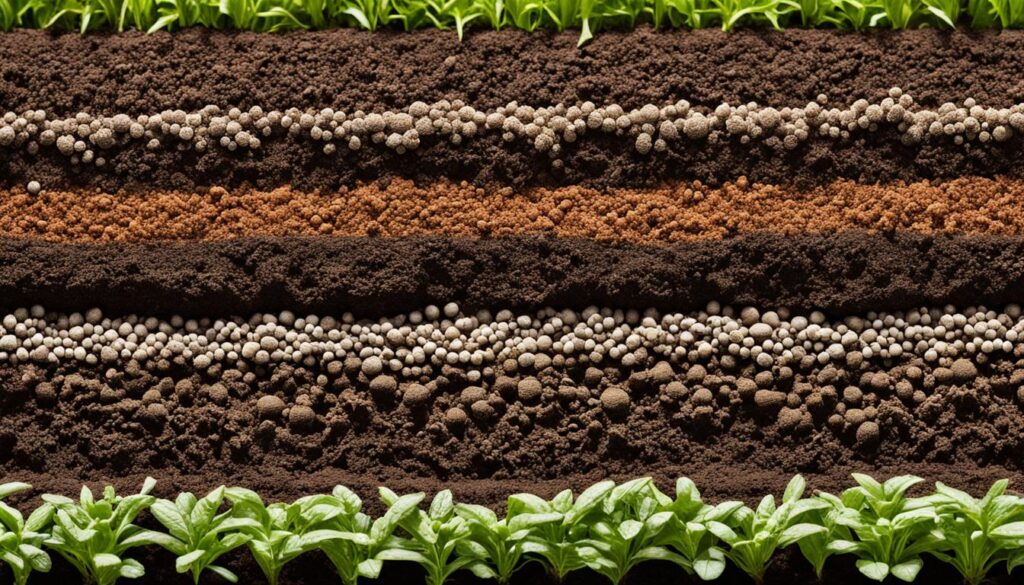
With a good crop rotation plan, your land can reach its full potential. This means a healthy, productive, and strong farming operation for many years.
crop rotation
Crop rotation is a key farming method that benefits farmers and the planet. It involves changing the crops grown on the same land each year. This approach boosts soil nutrients, fights pests and diseases, and supports sustainable agriculture.
One big plus of crop rotation is its effect on soil health. Different crops take various nutrients from the soil. By switching crops, farmers make sure the soil gets all the nutrients it needs. This keeps the soil healthy, holds more water, and makes it more fertile.
Disrupting Pest and Disease Cycles
Crop rotation is great for controlling pests and diseases. By changing what crops are grown, farmers stop pests and diseases from spreading. This cuts down on the use of harmful chemicals, making farming better for the planet.
- Crop rotation breaks the cycle of pests and diseases, lowering the risk of infestations.
- Planting different crops can starve pests and diseases, making the land less welcoming to them.
- This method encourages biodiversity, letting good insects and microorganisms fight pests naturally.
Using crop rotation is smart for your farm’s long-term health and productivity. It cares for the soil and stops pests and diseases in their tracks. This practice can help you make the most of your farm and support a sustainable future in agriculture.
Pest and Disease Management
Crop rotation is a key strategy for managing pests and diseases on your farm. By changing crops often, you stop harmful organisms from spreading. This method cuts down on the need for harmful pesticides, which are bad for the environment and people.
Using non-host crops in your rotation is crucial for pest control and disease prevention. These crops are safe from pests and diseases, breaking the cycle of infestations. Diversifying your crops makes farming more sustainable and reduces the use of pesticides.
Breaking the Pest and Disease Cycle
Crop rotation stops pests and diseases in several ways:
- It removes the plants pests and diseases need to survive
- It starves or displaces pests that can’t live on other crops
- It introduces natural predators and competitors to control pests
- It improves soil health and diversity, making it hard for pests to thrive
Plan your crop rotation to target pests and diseases in your area. This way, you can fight pests and diseases effectively without using harmful pesticides. It’s a sustainable way to keep your farm healthy.
Creating a good crop rotation plan is a wise choice for your farm’s future. It stops pests and diseases, leading to healthier crops, more yields, and a better sustainable farming approach.
Weed Control
Effective weed management is key to sustainable farming. Crop rotation is a big part of this. By changing what crops grow in a spot often, you make it harder for weeds to survive. Weeds find it tough to adjust to the changing conditions.
Crop rotation also helps with weed management in other ways. It works well with cover cropping and pulling weeds by hand. Together, these methods cut down on the need for harmful herbicides. This approach helps control weeds and supports integrated pest management and sustainable agriculture.
One big plus of crop rotation is how it breaks up weed life cycles. By switching crops, you stop any one weed from taking over. This leads to a mix of weeds that’s easier to handle.
| Crop Rotation Benefits for Weed Control | Explanation |
|---|---|
| Disrupts weed life cycles | Rotating crops stops any one weed from becoming too common. |
| Promotes diverse weed community | A mix of weeds is simpler to manage than a bunch of the same ones. |
| Integrates with other weed control tactics | Combining crop rotation with other methods makes weed control more effective and sustainable. |
Using crop rotation is a big step towards better weed management. It also helps with integrated pest management and sustainable agriculture.
“Crop rotation is a powerful tool in the integrated pest management toolbox, helping to disrupt weed life cycles and create a more diverse, balanced weed community on the farm.”
Economic and Environmental Benefits
Using crop rotation brings big wins for farmers on both the wallet and the planet. By mixing up what you grow and when, you can increase your crop yields and cut down on production costs.
One big plus of crop rotation is it cuts down on the need for expensive fertilizers and pesticides. By growing different crops, you use nature to keep the soil healthy and fight pests naturally. This means you spend less on chemicals, saving you money and boosting your farm’s profits.
Also, crop rotation is great for the planet. It helps create diverse ecosystems and healthy soil, lowering your carbon footprint. This is what people want more of, making your farm more appealing to eco-conscious buyers.
| Benefit | Description |
|---|---|
| Increased Crop Yields | Crop rotation helps to replenish soil nutrients, leading to higher yields and improved overall productivity. |
| Reduced Production Costs | By minimizing the need for costly inputs like fertilizers and pesticides, crop rotation can significantly lower your operating expenses. |
| Enhanced Environmental Sustainability | Crop rotation promotes biodiversity, improves soil health, and reduces the environmental impact of your farming practices. |
| Increased Demand for Organic Produce | Consumers are increasingly seeking out sustainably-grown, organic crops, which can provide a competitive advantage for farmers who adopt crop rotation. |
Embracing crop rotation can bring many benefits to your farm. It makes better use of your land, lowers costs, and supports sustainable farming. This approach sets you up for long-term success and helps make farming better for the planet.
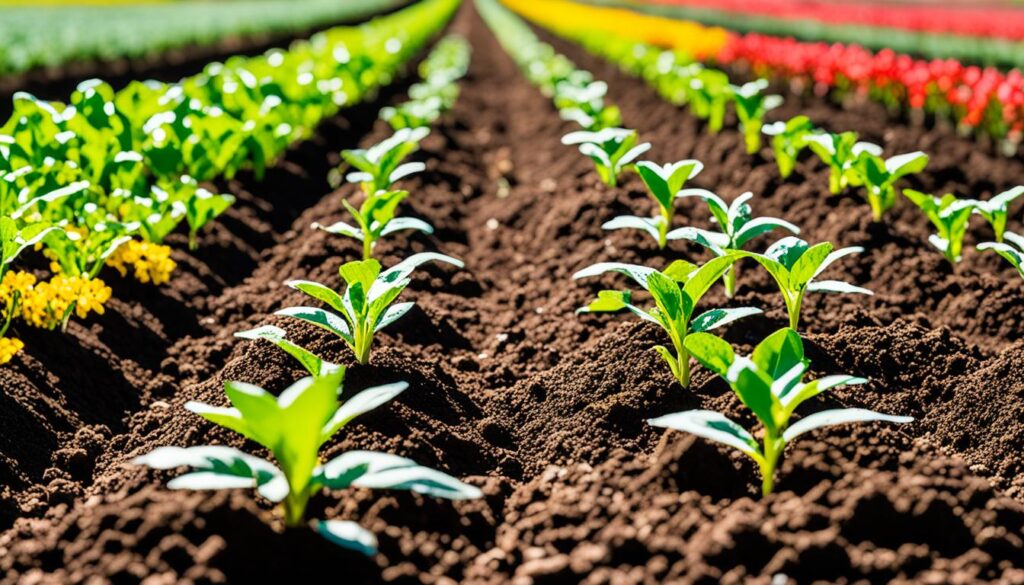
Conclusion
Starting your journey to sustainable farming means embracing crop rotation. This method is proven and very useful. By rotating your crops regularly, you gain many benefits. These benefits improve soil health, crop resilience, and farming sustainability.
Using diverse crop rotations helps revitalize your soil’s fertility. It also naturally controls pests and diseases. This approach boosts your farm’s ecosystem health. It cuts down on synthetic inputs and ensures your farm’s long-term success.
As sustainable farming grows in demand, your use of crop rotation puts you ahead. It shows your commitment to a resilient, eco-friendly food system. By embracing crop rotation, you pave the way for a future where your farm and nature work together.
FAQ
What is crop rotation?
Crop rotation means growing different crops in the same land over years, not the same crop over and over. This method keeps the soil healthy, stops pests and diseases, and helps crops grow better.
Why is crop rotation important?
It’s key for soil health and fighting pests and diseases. It also helps with sustainable farming by cutting down on synthetic fertilizers and pesticides.
What are the benefits of crop rotation?
It boosts soil health, fights pests and diseases, and increases crop yields. It also cuts down on costs and promotes growing a variety of crops.
How does crop rotation enhance soil health?
It makes soil healthier and more productive. By growing different crops, it improves soil structure and nutrient levels. This helps with nutrient cycling.
How does crop rotation help manage pests and diseases?
It stops pests and diseases by changing crops often. This breaks the life cycles of harmful organisms, reducing the need for pesticides.
How does crop rotation help with weed control?
It’s key for controlling weeds. Changing crops often makes it hard for weeds to adapt, keeping them in check.
What are the economic and environmental benefits of crop rotation?
It boosts yields, cuts down on costs, and promotes sustainable farming. It also improves soil health, reduces pollution, and supports biodiversity.
Source Links
- https://vlsci.com/blog/crop-rotation-benefits/ – Benefits of Crop Rotation & Soil Management | Verdesian Life Sciences
- https://eos.com/blog/crop-rotation/ – Crop Rotation: Benefits Of Using And Application Strategies
- https://usfarmersandranchers.org/stories/sustainable-food-production/the-benefits-of-crop-rotation-and-diversity/ – The Benefits of Crop Rotation and Diversity – U.S. Farmers & Ranchers in Action
Creating a Balanced Garden Ecosystem with Companion Planting
Ever wondered how ancient gardeners got such great harvests? The secret is in companion planting. This method uses the natural links between plants to make gardens thrive. We’ll dive into the ancient wisdom of companion planting and show how it can make your garden a lush, self-sustaining place.
Key Takeaways
- Discover the ancient roots of companion planting and how it can benefit your modern garden
- Learn how to leverage natural pest control and enhance biodiversity using strategic plant pairings
- Optimize your garden’s space and yield through thoughtful companion planting techniques
- Attract beneficial insects, pollinators, and wildlife to create a thriving garden ecosystem
- Explore proven companion planting combinations for soil health, visual appeal, and long-term success
Imagine a garden that thrives without harmful pesticides or too much work. Companion planting is the answer. By using this method, you can make your garden a lush, thriving space that works with nature. It’s time to bring this ancient wisdom into your modern garden.
The Ancient Wisdom of Companion Planting
Companion planting has been around for a long time, going back to ancient times. It’s based on the “Three Sisters” method from Indigenous American farming. This method uses corn, beans, and squash together.
Tracing the Origins: From Ancient Civilizations to Modern Gardens
For centuries, farmers used companion planting in many cultures. The early cottage gardens were designed to help plants work together. They picked plants that helped each other out, like fighting pests or sharing nutrients.
The Three Sisters: An Indigenous Tradition of Symbiotic Planting
The “Three Sisters” method is a key part of Indigenous American farming, going back over 3,000 years. It’s about growing corn, beans, and squash together. Corn helps the beans grow by providing a structure for them to climb on.
Beans are great at making the soil richer with nitrogen. Squash spreads out and covers the ground, keeping it moist, stopping weeds, and keeping the soil cool.
“The Three Sisters method embodies a harmonious relationship between three staple crops: corn, beans, and squash.”
This old way of planting is still guiding today’s gardeners. They aim to mimic the natural balance found in nature.
Unleashing Nature’s Power: Companion Planting Benefits
Companion planting is a natural way to control pests and boost garden diversity. By pairing certain plants, you can keep pests away and draw in helpful insects. This creates a balanced and thriving garden ecosystem.
Natural Pest Control: Repelling Pests with Strategic Plant Pairings
Some flowers, like nasturtiums and marigolds, have strong smells that pests don’t like. These plants can keep aphids, beetles, and other pests away. Adding them to your garden helps you avoid harsh chemicals and keeps your garden healthy.
Enhancing Biodiversity: Attracting Beneficial Insects and Wildlife
Having different plants in your garden improves soil health and fights pests and diseases. By choosing a variety of flowers, you’ll draw in helpful insects, birds, and wildlife. Flowers like bee balm and echinacea help bees and butterflies, making sure plants can reproduce well. This makes your garden stronger and healthier.
“By incorporating companion plants, you can create a natural pest control system while attracting a diverse array of beneficial insects and wildlife, resulting in a thriving and balanced garden ecosystem.”
Companion planting is a green and complete way to garden. It uses nature to control pests, increase diversity, and improve plant health. With the right plant combinations, your garden can be full of life and self-sustaining.
Optimizing Space and Yield with Companion Planting
Root crops like radishes, carrots, and beets are great for companion planting. They grow well together and can be harvested at different times. This makes them perfect for a busy garden.
By planting these vegetables together, gardeners can use space wisely and get fresh produce all season. It’s a smart way to make the most out of your garden.
Root Crop Companions: Maximizing Space and Harvest Potential
Radishes, carrots, and beets work well together. Radishes grow fast and can be planted between the slower-growing carrots and beets. This way, you use space well and can pick radishes early.
As you pick the radishes, the carrots and beets have room to grow. This method makes your garden more efficient and productive.
But there’s more to companion planting for root crops. Adding plants like dill, lettuce, beans, and cucumbers between them makes your garden better. It uses space well and makes your garden more diverse and productive.
“By embracing the principles of companion planting, gardeners can transform their root crop beds into veritable oases of productivity and efficiency.”
Success comes from knowing how each root crop grows and when it’s ready to be picked. With some planning and creativity, you can use companion planting to make your garden better. You’ll get more from your space and enjoy a bountiful harvest.
Attracting Beneficial Insects: Pollinators and Predators
Creating a great garden is not just about growing plants. It’s also about inviting beneficial insects to your garden. These insects are key to a balanced garden. They help pollinate plants and eat pests.
Cover crops like clover and buckwheat are great for your garden. They offer homes for insects and improve the soil. Clover fixes nitrogen and shelters insects, making the soil richer. Buckwheat grows fast and has many small flowers. These attract beneficial beetles, lacewings, and wasps.
To make your garden a haven for pollinators, plant a variety of flowers. Think about adding lavender, borage, calendula, and sunflowers. These flowers will draw in bees and butterflies, helping your garden grow well.
“Attracting beneficial insects is a key component in creating a balanced garden ecosystem. By providing the right companion plants, you can harness the power of nature to reduce pests and promote healthy plant growth.”
A garden with many different plants is a healthy garden. By choosing plants that attract beneficial insects, you’ll create a lush, productive, and balanced garden.
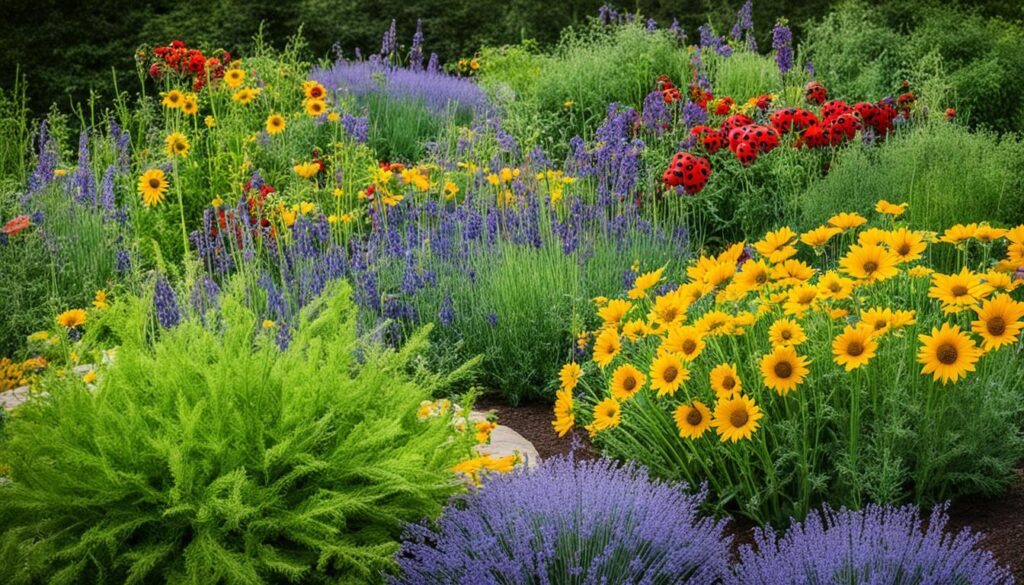
| Companion Plant | Insects Attracted | Benefits |
|---|---|---|
| Clover | Various predatory insects, including beetles and lacewings | Nitrogen fixation, soil enrichment, habitat provision |
| Buckwheat | Parasitic wasps, hover flies, ladybugs | Fast-growing, abundant small flowers, habitat for beneficial insects |
| Lavender, Borage, Calendula, Sunflowers | Bees, butterflies, hummingbirds | Attractive to a wide range of pollinators, ensuring healthy harvests |
Embracing Diversity: Flower Companions for a Vibrant Garden
Creating a beautiful garden starts with picking flowers that look good together. By using flower companion planting, you can make a garden that looks great all season. This approach makes your garden diverse and thriving.
Complementary Colors and Bloom Times for Visual Appeal
Choosing the right colors for your flowers is key to a stunning garden. Pairs like blue and orange or purple and yellow make your garden pop. Mixing different shades within these pairs adds depth and interest.
It’s also important to plan when your flowers will bloom. Mixing early, mid, and late bloomers ensures your garden stays colorful all season. This approach also feeds pollinators and keeps your garden beautiful over time.
Annual and Perennial Flower Pairings for Continuous Beauty
Knowing the difference between annual and perennial flowers helps plan a beautiful, easy garden. Annuals bloom for one season and need replanting each year. Perennials come back every year, spreading and becoming a garden staple.
Using both annual and perennial flower companions means your garden looks great with less work. This mix offers continuous color and texture. It attracts pollinators and delights everyone who sees it.
“The true essence of a garden lies in its ability to captivate the senses and nourish the soul. By embracing the diversity of flower companions, we can cultivate a sanctuary that reflects the ever-changing beauty of nature.”
balanced garden ecosystem companion planting
Companion planting is a great way to make your garden better. Some plants help improve the soil, making it healthier for all plants around them. For example, marigolds can keep pests away and make the soil healthier Borage adds important minerals to the soil and has deep roots that help the soil structure. Comfrey pulls nutrients from deep in the soil and releases them as it breaks down, making the soil richer. Adding these plants helps create a garden that’s full of life and healthy soil.
Encouraging Biodiversity: Creating a Haven for Wildlife
Having many different plants in your garden makes the soil healthier and keeps pests away. By planting flowers that attract insects, birds, and other wildlife, you make your garden a better place for them. Flowers like bee balm and echinacea help bees and butterflies, which is good for your plants and your garden. This variety makes your garden stronger and more able to fight off diseases and pests on its own. Adding things like bee hotels and water sources keeps the good bugs in your garden.
| Companion Plants for Soil Health | Benefits |
|---|---|
| Marigolds | Suppress nematodes, improve soil health |
| Borage | Add trace minerals, improve soil structure |
| Comfrey | Draw nutrients from deep in the soil, enrich upper soil layers |
“By incorporating a diverse mix of plants, gardeners can create a thriving, balanced garden ecosystem that supports a wide range of beneficial species.”
Companion Planting Combinations for Success
In sustainable gardening, pairing plants wisely can bring many benefits. By matching nitrogen-fixing plant companions with heavy feeders, and pest-repellent companion plants with pest-attracting trap crops, you can make your garden thrive naturally.
Nitrogen-Fixing Plants and Heavy Feeders
Legumes like peas, beans, or clover fix nitrogen in the soil. They grow well with heavy feeders like corn, tomatoes, or cabbage. These legumes add nitrogen, helping nearby plants grow strong. This nutrient-sharing plant pairing keeps soil fertile and cuts down on synthetic fertilizers.
Pest-Repellent and Pest-Attracting Plant Pairs
Plants with strong smells, like marigolds, garlic, or onions, keep pests away. They act as pest-repellent companion plants. Near carrots or potatoes, they protect against aphids or nematodes. Also, plants like dill or fennel draw pests away from other plants, acting as pest-attracting trap crops.
This mix of pest-repellent and pest-attracting plants helps keep your garden balanced. It uses natural pest management to keep pests away.
Using these companion planting methods, you can make your garden strong and self-sustaining. It will need little care and support the health and productivity of your plants for a long time.
Planning and Implementing Companion Planting
Learning about companion planting takes some planning. Use companion planting resources and gardening guides to make your garden thrive. These guides, like The Old Farmer’s Almanac Companion Planting Guide and Rodale’s Basic Organic Gardening, share tips on pairing plants for the best results.
Don’t just stop there. Contact your local cooperative extension services for advice from gardening pros. They know which plants work well together in your area. They can help with companion plant placement and garden layout design to make your garden better.
Designing Your Garden Layout for Optimal Plant Interactions
Arranging your garden right is key to a great companion planting setup. Think about how tall the plants are, what light they need, and what soil they like. Putting plants together that work well can make better growing conditions for everyone. Use a mix of plants, from low-growing ones to tall ones, to make your garden look good and work well.
“Companion planting is not just about growing plants side by side; it’s about creating a harmonious, symbiotic relationship that benefits the entire garden ecosystem.”
Use companion planting resources and plan your garden well. This way, you can make the most of companion planting. You’ll have a garden that’s full of life, productive, and good for the planet.
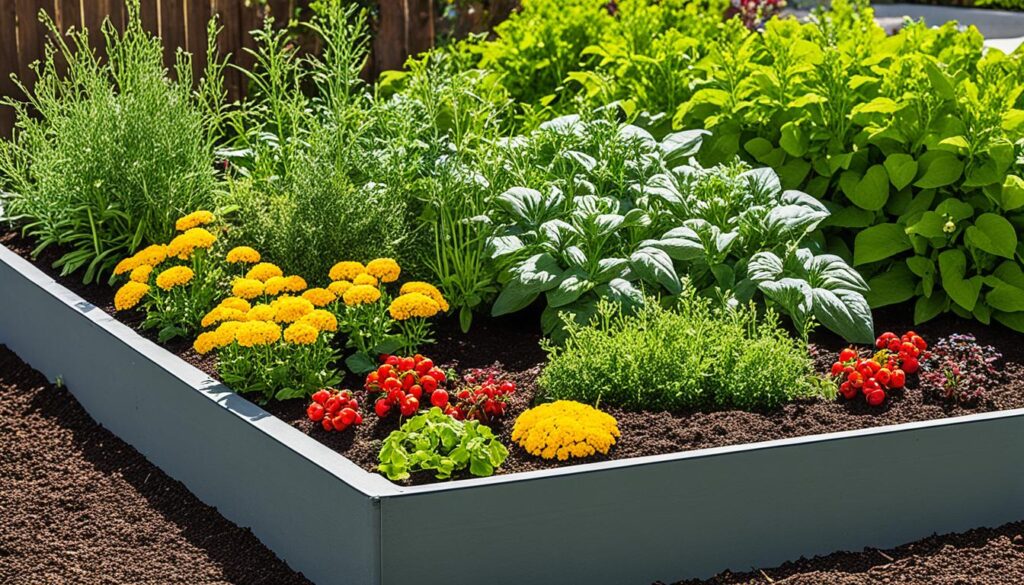
Nurturing a Thriving Garden Ecosystem
To make your garden vibrant and sustainable, watch and adapt. Keep an eye on how plants interact and your garden’s health. This helps you choose the best companion planting strategies. Regular checks let you spot and fix any issues, like adding pest-repellent plants or moving plants around.
Maintaining Balanced Plant Communities Through Observation
Watching how plants interact in your garden is key for its health. Notice how they grow, who eats them, and how strong they are. This helps you adjust your companion planting to make sure each plant does well. It keeps your ecosystem balanced.
Embracing Sustainable Gardening Practices for Long-Term Success
Using sustainable gardening methods helps your garden last longer and be stronger. Add organic stuff to your soil to help it and the plants. Don’t use harmful pesticides and fertilizers. Go for natural ways like planting friends together and using cover crops instead. These eco-friendly choices make your garden self-sustaining and healthy for years.
| Sustainable Gardening Practices | Benefits |
|---|---|
| Incorporating organic matter | Supports soil health and biodiversity |
| Avoiding synthetic pesticides and fertilizers | Promotes a balanced, self-sustaining ecosystem |
| Implementing cover cropping | Enhances soil fertility and nutrient cycling |
Understanding your garden’s ecosystem and using sustainable gardening practices leads to a thriving garden. It will keep doing well for many years.
Conclusion
Companion planting is a great way to make your garden healthier and more productive. It helps control pests, improves soil, and adds beauty to your garden. By using companion planting, you can make your garden a thriving place.
Try new things, watch how they do, and change your plans as needed. This way, you can make the most out of your garden. Companion planting brings together different plants to create a balanced garden.
This approach helps your garden grow well and supports many kinds of life. It’s a way to make your garden better for you and the environment. Start companion planting and see how your garden changes into a beautiful, self-sustaining place.
FAQ
What is the history of companion planting?
Companion planting has a long history, dating back to ancient times. The Mayans, Egyptians, and Indigenous peoples used it to boost crop yields and keep soil healthy.
What is the “Three Sisters” companion planting method?
The “Three Sisters” method comes from Native American tribes. It involves growing corn, beans, and squash together. Corn supports the beans, beans fix nitrogen, and squash keeps the soil moist and weeds down.
How does companion planting help with natural pest control?
Flowers like nasturtiums and marigolds keep pests away with their strong smells and bright colors. They help protect other plants from aphids, beetles, and other pests.
How can companion planting improve soil health and biodiversity?
Plant diversity in the garden makes soil healthier and cuts down on pests and diseases. By using a mix of plants, you attract beneficial insects and wildlife. Flowers like bee balm help bees and butterflies, which is good for plant growth and harvest.
How can companion planting help with space and yield optimization?
Plants like radishes, carrots, and beets grow well together and at different times. By planting them together, you use space better and get fresh produce all season.
How can companion planting enhance the visual appeal of a garden?
Picking flowers with matching colors makes the garden look better. Colors like blue and orange or purple and yellow stand out together. Mixing different shades adds depth and beauty to the garden.
How can companion planting improve soil quality?
Some plants make the soil better for all plants around them. Marigolds fight nematodes and improve soil health. Borage adds minerals and helps soil structure with its deep roots.
What are some effective companion planting combinations?
Legumes like peas and beans work well with heavy feeders like corn and tomatoes. They keep the soil fertile. Planting marigolds, garlic, or onions near other plants keeps pests away with their smell.
Where can I find reliable resources for companion planting guidance?
The Old Farmer’s Almanac Companion Planting Guide and Rodale’s Basic Organic Gardening book are great resources. Local extension services and gardening groups also offer advice on what plants go well together.
How can I maintain a thriving companion planting system?
Keeping a garden healthy means watching the plants and insects closely. Making changes as needed helps keep the garden balanced and productive.
Source Links
Understanding Soil Health: The Foundation of Sustainable Gardening
Do you know the secret to vibrant, thriving plants? It’s right beneath your feet – in the soil! Soil health is key to sustainable gardening, but many gardeners forget this important part. Imagine a garden full of life where plants grow well without harsh chemicals. This is possible with healthy soil.
Your soil is alive, full of tiny creatures and insects that help plants grow. By taking care of this underground world, you can make a garden that’s beautiful, kind to the planet, and sustainable.
Key Takeaways
- Soil health is the foundation for sustainable gardening, supporting plant growth and ecosystem balance.
- A diverse soil biome, including beneficial microbes and organisms, contributes to nutrient cycling, organic matter decomposition, and carbon sequestration.
- Proper soil structure and moisture retention are crucial for healthy plant roots and resilience against environmental stresses.
- Sustainable soil management practices, such as composting and cover cropping, can improve soil fertility and reduce the need for chemical inputs.
- Soil testing and targeted amendments can help address specific nutrient deficiencies and balance the soil’s pH for optimal plant performance.
The Living Soil: A Microbial Wonderland
Underneath your feet, the soil is full of soil microbes like beneficial bacteria, fungi, protozoa, and nematodes. These tiny creatures are key to a healthy garden. They help break down organic matter, release nutrients, and keep plants safe from diseases.
Beneficial Bacteria and Fungi
Beneficial soil bacteria work hard to turn complex organic materials into nutrients for your plants. Soil fungi create networks that carry nutrients to your plants’ roots. These tiny helpers make sure your garden gets the nutrients it needs to grow strong.
Protozoa and Nematodes
Soil protozoa and soil nematodes are also crucial. They eat harmful bacteria and fungi, keeping the soil balanced. This balance is key to your plants getting the right nutrients and staying healthy.
By taking care of the beneficial soil bacteria, soil fungi, soil protozoa, and soil nematodes, you help your garden grow. You’ll get more healthy plants and a garden that takes care of itself.
“The soil is the great connector of lives, the source and destination of all.” – Wendell Berry
Nutrient-Rich Soil: The Key to Healthy Plants
Sustainable gardening means feeding your plants naturally, not with synthetic fertilizers. The key is to create soil rich in nutrients for strong plant growth. Soil’s living things break down things like compost and plant leftovers, giving your plants the nutrients they need.
Natural Nutrient Cycling
This process of nutrient cycling gives your plants what they need and keeps nutrients balanced. It’s better than synthetic fertilizers, which can cause problems. This way, your garden grows healthy and eco-friendly.
Balanced and Sustainable Nutrient Supply
By building soil nutrients, using organic matter, and encouraging nutrient cycling, you make a sustainable soil system. This supports plant nutrition and makes your garden lush and healthy. It also helps your garden stay strong over time.
“The key to a successful, sustainable garden lies in the health of your soil. By nurturing the natural nutrient cycles, you’ll unlock the true potential of your plants.”
Soil Structure and Water Retention
In sustainable gardening, the way your soil is structured is key. It affects aeration, drainage, and how well it holds water. These are crucial for your plants’ health and strength.
Adding organic matter like compost or manure helps improve soil structure. These materials help create a crumbly, porous soil. This makes air and water move better through the soil, helping roots grow and plants use water well.
Organic soils are great at keeping water in, which is vital in dry areas or where rain is unpredictable. They make plants more drought resilient. This means they can survive with less water and do well in tough conditions.
| Soil Property | Importance | Benefit |
|---|---|---|
| Soil Structure | Influences aeration, drainage, and water retention | Promotes plant health and resilience |
| Organic Matter | Improves soil aggregation and porosity | Enhances water movement and drought tolerance |
| Soil Porosity | Allows for better air and water circulation | Supports root growth and plant health |
By focusing on your soil’s structure and how it holds water, you can make your garden thrive. This approach helps your garden deal with climate changes and unpredictable weather. Taking care of your soil is key to a successful and lasting garden.
Biodiversity and soil health
In organic gardening, having a variety of life forms is key. This includes everything from tiny microbes under the soil to different plants above. A balanced ecosystem is vital for keeping your garden healthy.
Mycorrhizal Associations
The heart of this balance is the partnership between plant roots and mycorrhizal fungi. These fungi help plants reach more nutrients in the soil. In return, plants give them sugars from photosynthesis. This relationship makes plants healthier and more resistant to problems.
Companion Planting and Ecosystem Balance
Having different plants in your garden is also important for balance. By using various crops and cover plants, you can fight pests and diseases naturally. This way, you use helpful insects and microbes to keep your garden healthy without chemicals.
By focusing on soil biodiversity, you can create a garden that’s full of life. It will give you lots of food and help the environment. Discover how the living soil works, and see your garden grow with nature’s help.
Pest and Disease Management Naturally
Organic gardening focuses on preventing pests and diseases with natural methods. It starts with healthy soil, which helps plants stay strong. Healthy soil has many microorganisms that fight diseases and make plants stronger against pests.
Disease Suppression through Diverse Microbes
Beneficial microbes in the soil work together to stop plant diseases. They compete with harmful organisms for resources and produce antibiotics. By using organic gardening, you can use nature’s own ways to fight diseases.
Resilient Plants through Proper Nutrition
Plants that get the right nutrients are stronger against pests and diseases. They grow stronger cell walls and have better immune systems. They also make more compounds that keep pests away. Using companion planting helps plants work together to stay healthy.
| Organic Gardening Practice | Benefit for Pest and Disease Management |
|---|---|
| Diverse Soil Microbiome | Suppresses plant diseases through competition, antibiotic production, and direct parasitism of pathogens |
| Balanced Nutrient Supply | Strengthens plant immunity and production of natural pest-deterring compounds |
| Companion Planting | Enhances plant resilience through mutually beneficial relationships between different crops |
Organic gardeners use natural methods to manage pests and diseases. They focus on the soil’s living diversity and give plants the right nutrients. This approach creates a healthy, sustainable garden.
The Role of Organic Matter
Organic matter is key to a healthy garden. Adding different organic materials to your soil brings many benefits. These help plants grow better and make your garden more sustainable.
Composting and Cover Crops
Composting changes kitchen scraps and yard waste into a soil booster. It helps reduce waste and gives your garden a valuable resource. Cover crops like legumes and clover help during off-growth seasons. They stop soil erosion, fight weeds, and add organic matter when plowed under.
Mulching for Moisture Retention
Using mulch, such as straw or wood chips, on your garden beds is very helpful. It keeps the soil moist, stops weeds, and keeps the soil temperature right. This is great for the tiny helpers that make plants grow and cycle nutrients.
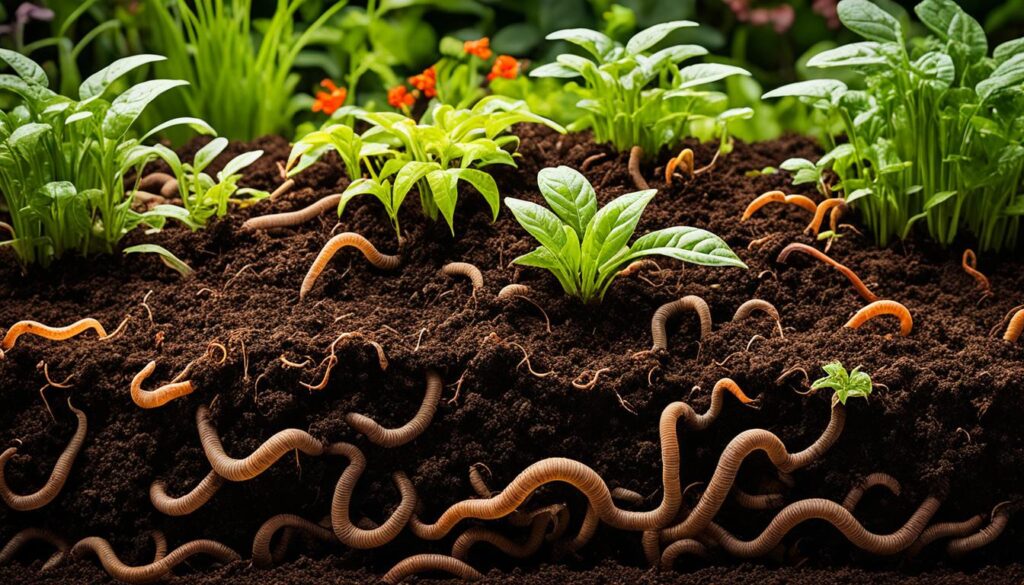
“The health of soil, plant, animal and man is one and indivisible.” – Lady Eve Balfour
Using organic matter makes your garden strong and healthy. Practices like composting, cover cropping, and mulching work together. They build a strong soil base for sustainable gardening for many years.
Soil Testing and Amendments
Healthy soil is key to sustainable gardening. Soil testing helps you understand your soil’s makeup. This lets you choose the right soil amendments to boost fertility and pH levels. This supports the growth of healthy, strong plants.
Home soil testing kits give you insights into nutrient levels, organic matter, and pH balance. With this info, you can fix any issues. This ensures your plants get the nutrients they need to grow well.
Adjusting Soil pH
Soil pH affects nutrient availability. If your soil is too acidic or alkaline, you might need to adjust it. Using lime or sulfur can help. These amendments change the pH to create a better environment for plants.
Balancing Nutrient Levels
Soil tests show nutrient levels like nitrogen, phosphorus, and potassium. Knowing these levels lets you add amendments like compost or manure. This ensures your plants get the nutrients they need.
Adding organic matter, like compost or cover crops, improves soil structure and health. This supports sustainable gardening in the long run.
| Soil Amendment | Purpose | Recommended Application Rate |
|---|---|---|
| Limestone | Increase soil pH | 2-4 lbs per 100 sq ft |
| Sulfur | Decrease soil pH | 1-2 lbs per 100 sq ft |
| Compost | Improve soil structure and nutrient levels | 2-4 inches worked into the top 6-8 inches of soil |
| Balanced Organic Fertilizer | Provide a comprehensive nutrient boost | Follow product instructions for application rates |
Regular soil testing and targeted amendments create a nutrient-rich environment. This supports your plants’ health and vitality. It ensures a bountiful harvest year after year.
“The key to a successful garden is in the soil. By understanding and nurturing the foundation of your growing space, you unlock the true potential of your plants.”
Carbon Sequestration and Climate Change Mitigation
As an organic gardener, you have a big role in fighting climate change. The health of your soil is key in carbon sequestration and climate change mitigation.
Organic gardening helps pull carbon dioxide from the air and store it in the soil. The organic matter you add acts as a carbon sink. This is crucial for fighting climate change.
- Organic gardening builds up organic matter in the soil, which stores carbon.
- Healthy soils can hold a lot of atmospheric carbon, lowering greenhouse gas levels.
- By using sustainable gardening methods, you help fight climate change and show environmental responsibility.
| Sustainable Gardening Practice | Carbon Sequestration Benefits |
|---|---|
| Composting | Adds organic matter to the soil, increasing its carbon-holding capacity. |
| Cover Cropping | Promotes the growth of plant roots, which help store carbon in the soil. |
| Mulching | Retains soil moisture and prevents the release of stored carbon into the atmosphere. |
Organic gardening helps make our planet sustainable and fights climate change. Your garden can be a carbon sink, tackling global environmental issues.
“Soil is the foundation of life, and it is our responsibility to protect and nurture it. Through organic gardening, we can create a healthier, more resilient planet for future generations.”
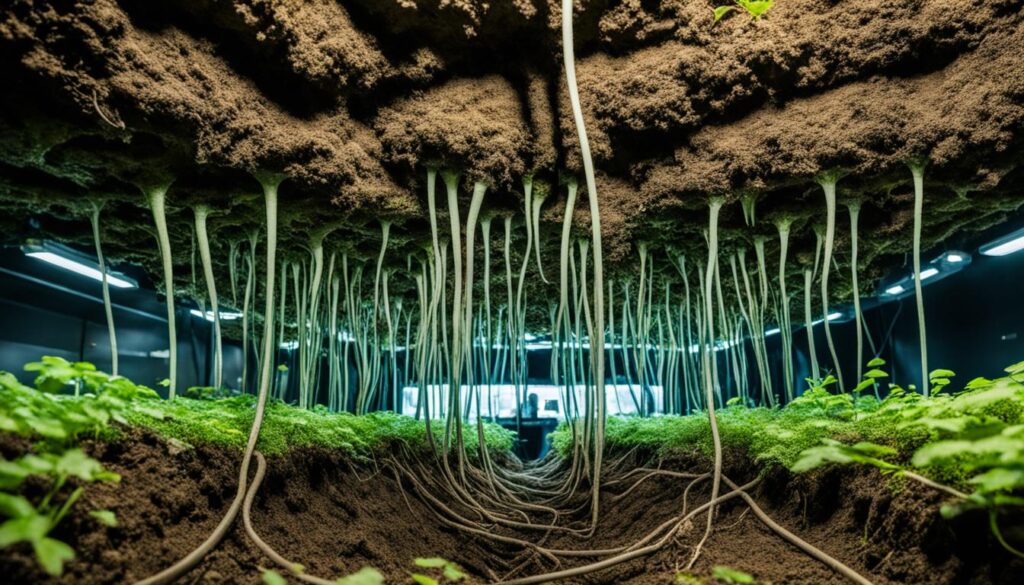
Soil Health: The Foundation of Sustainable Gardening
Soil health is key to sustainable gardening. It’s vital for growing plants that are healthy and in harmony with nature. By focusing on soil health, gardeners can grow more food and protect the environment.
Organic gardening means working with nature, not against it. It avoids synthetic fertilizers and pesticides. Instead, it builds a living ecosystem in the soil. This way, plants get the nutrients they need and supports many living things, making gardens healthy and full of life.
Understanding the life under our feet is crucial for organic gardening. Soil is full of tiny helpers like bacteria and fungi that are key for plant health. By taking care of these tiny helpers, gardeners can make their gardens strong and self-sufficient.
“Soil health is the foundation of sustainable gardening. By focusing on building and maintaining nutrient-rich, biologically diverse, and structurally sound soil, organic gardeners can create thriving gardens that are resilient, sustainable, and in tune with the natural world.”
Practices like cover cropping and composting help improve soil. They make it better at holding water and giving plants what they need. These methods help plants grow strong and support the environment by fighting climate change.
Soil health is the core of sustainable gardening. By taking care of the soil, gardeners grow healthy plants and protect nature. This way, they can enjoy a garden that’s full of life and good for the planet.
Conclusion
Your journey to sustainable gardening starts with soil health. By understanding life beneath the surface, you can make your garden thrive. It will give you lots of harvests and help the environment.
Using organic gardening methods like compost and natural pest control helps. These practices feed soil microbes and improve nutrient cycling.
As a gardener, you play a big role in fighting climate change by storing carbon in the soil. Your focus on soil health helps your plants and protects our ecosystem. By following organic gardening, you become a guardian of the earth, keeping your garden and the planet healthy for the future.
Soil health is key to your sustainable gardening journey. By making your soil rich and diverse, you unlock your garden’s full potential. You’ll get healthy plants and lots of food while helping the environment.
FAQ
What is the importance of soil health in gardening?
Soil is key to life on Earth, linking plants, the atmosphere, and our health. It’s vital for sustainable gardening and plant growth. Healthy, nutrient-rich soil is essential.
How do soil microorganisms contribute to soil health?
Soil is full of tiny living things like bacteria and fungi. These microbes help break down organic matter and make nutrients for plants. They also protect plants from diseases.
How does organic gardening nourish plants naturally?
Organic gardening aims to feed plants without synthetic fertilizers. It focuses on building nutrient-rich soil. This lets soil organisms break down organic matter and release nutrients for plants.
Why is soil structure important in organic gardening?
Soil structure is crucial in organic gardening. It affects aeration, drainage, and water retention, which are key for plant health. Adding organic matter like compost improves soil structure, helping roots grow and air and water move through the soil.
How does organic gardening encourage biodiversity?
Organic gardens support life above and below ground. Soil microbes help plants by making nutrients available and fighting diseases. Planting a variety of crops helps pests and diseases by supporting beneficial insects and organisms.
How can organic gardening practices help manage pests and diseases naturally?
Organic gardening uses natural ways to fight pests and diseases. Healthy soil and diverse microorganisms help prevent many garden problems. Planting certain crops together can also keep pests away and attract good insects.
Why is the incorporation of organic matter essential in organic gardening?
Adding organic matter is key in organic gardening. Practices like composting and mulching enrich soil and help microorganisms. This creates a good environment for plants to grow.
How can soil testing benefit organic gardeners?
Soil testing helps organic gardeners know what their soil needs. It shows the pH, nutrient levels, and organic matter content. This info helps gardeners choose the right amendments for their soil.
How does organic gardening contribute to climate change mitigation?
Organic gardening helps fight climate change by storing carbon in soil. Organic matter acts as a carbon sink, pulling CO2 from the air. By gardening organically, people can help reduce carbon emissions and support sustainability.
Source Links
- https://mountviewservices.com/understanding-soil-health-a-key-to-sustainable-landscaping/ – Understanding Soil Health – A Key to Sustainable Landscaping
- https://alluvialsoillab.com/blogs/news/the-crucial-role-of-soil-in-organic-gardening-nurturing-a-sustainable-harvest-enhancing-soil-health-through-testing – The Crucial Role of Soil in Organic Gardening: Nurturing a Sustainable Harvest, Enhancing Soil Health Through Testing | Alluvial Soil Lab
- https://extension.oregonstate.edu/catalog/pub/em-9409-understanding-soil-health-biota-farms-gardens – Understanding Soil Health and Biota for Farm and Garden
Improving Soil Health with Companion Planting
Are you tired of dealing with poor soil in your garden? Wondering if there’s a natural way to make your soil better? Look into companion planting. By pairing certain plants together, you can make your soil richer and healthier. This creates a thriving garden ecosystem.
This article will show you how companion planting can improve soil health. It helps with fertility, keeps nutrients balanced, and supports good microbes. It also cuts down on the need for harmful chemicals. Get ready to see how this gardening trick can change your garden!
Key Takeaways
- Companion planting can significantly enhance soil fertility and nutrient balance.
- Strategic plant pairings can create a more diverse and resilient soil ecosystem.
- Certain companion plants can help suppress pests and diseases, reducing the need for chemical interventions.
- Integrating cover crops and green manures into your companion planting system can further improve soil health.
- Companion planting can also help your plants become more drought-resistant and better able to withstand challenging environmental conditions.
The Benefits of Companion Planting
Companion planting is great for making soil healthier and more fertile. By pairing soil-enriching plants and nutrient-boosting plants, you make a garden that helps each plant grow better. This method makes your garden more vibrant and healthy.
Enhancing Soil Fertility
Having different roots in your garden is key to better soil. Plants like broccoli and cabbage grow close to the surface. They work well with tomatoes, which have deeper roots. This way, they get different nutrients from the soil.
Adding plants like peas, beans, and clover can also help. These plants fix nitrogen in the soil. When they break down, they give back nitrogen to the soil. This cuts down on the need for chemical fertilizers.
Maintaining Nutrient Balance
Companion planting keeps the soil balanced and healthy. By growing many different plants, you make your garden strong against nutrient shortages. This keeps the soil rich and supports many types of crops.
“Companion planting is a powerful tool for gardeners and farmers alike, as it allows them to harness the natural synergies between plants to improve soil health and fertility.”
Companion planting is a big win for soil health. By choosing the right soil-enriching plants and nutrient-boosting plants, you create a garden that feeds itself. This leads to a garden full of diverse and healthy plants.
Understanding Companion Planting Arrangements
Successful companion planting means knowing how different plants work together and with their environment. Things like plant height, growth patterns, and how they fight pests or diseases are key. By picking and placing your plants right, you can make a garden that’s healthier and more productive.
When looking at companion planting arrangements, keep these main points in mind:
- Compatibility: Choose plants that grow well together, need similar nutrients, and resist pests and diseases.
- Companion planting techniques like intercropping, succession planting, and polycultures help use space better and increase diversity.
- Plan your companion planting patterns to make the most of light, water, and nutrients for all plants.
| Companion Plant | Beneficial Attributes | Ideal Companions |
|---|---|---|
| Marigolds | Repels nematodes, attracts beneficial insects | Tomatoes, peppers, eggplants |
| Nasturtiums | Trap crops for aphids, adds nutrients to soil | Cucumbers, radishes, cabbage |
| Chamomile | Improves soil health, deters pests | Onions, carrots, brassicas |
Learning about companion planting arrangements helps you make a garden that fights pests, diseases, and stress better.
“Companion planting is not just about which plants grow well together, but how they can support each other’s growth and health.”
Intercropping: Maximizing Space and Diversity
Intercropping means growing different crops together in one spot. It’s great for gardeners and small farmers. By mixing early and late crops, you can maximize your garden space and boost diversity. This method makes your garden look better and helps your plants grow healthier and more productive.
Planting Patterns and Techniques
Choosing the right companion planting patterns and techniques is key. For instance, grow quick-growing crops like lettuce or spinach with slower ones like peppers or tomatoes. This way, you use your space well.
Intercropping lets you use the unique growth and needs of different plants. It makes your garden stronger and more productive. You get better pest and disease control, richer soil, and a balanced nutrient cycle.
“Intercropping is a sustainable and efficient way to grow a diversity of crops in a limited space, while also supporting the overall health of your garden ecosystem.”
To make the most of intercropping, try out different patterns and techniques. Watch how your plants do together and adjust as needed. With creativity and care, you can enjoy the benefits of intercropping and turn your garden into a lush, diverse place.
Amending Soils with Companion Planting
Improving soil health is easy with companion planting. By picking the right plants together, you can fix nutrient gaps and make your soil richer. This method uses amending soil with companion plants to boost your garden’s health.
Adding nutrient-boosting plants to your garden helps refill the soil with what it needs. Legumes like peas or beans add nitrogen. Plants with deep roots, such as comfrey or dandelions, bring up minerals from deep down.
- Increase mulch around plant bases to retain moisture and improve soil structure
- Add earthworms to aerate compacted soils and enhance nutrient cycling
- Integrate cover crops to help replenish depleted soil nutrients and improve overall soil health
By choosing the right soil amendment techniques, your garden can become a place of growth and health. Watch your soil and pick the best companion plants to fill any gaps. This way, your garden will be full of life and productivity.
“Companion planting is a powerful tool for improving soil health and creating a more sustainable, self-regulating garden ecosystem.”
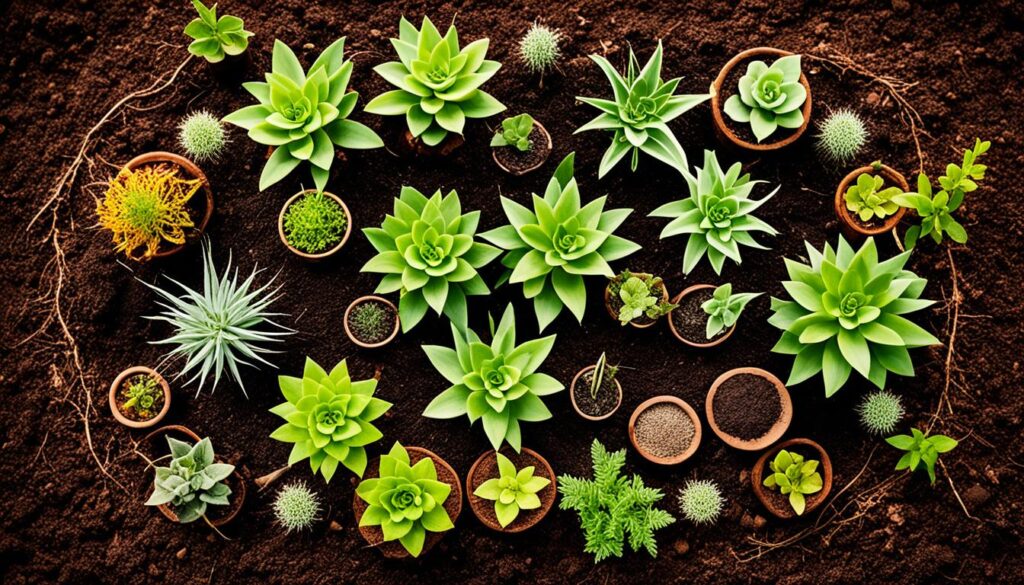
improving soil health with companion planting
Using companion planting can make your soil healthier and more lively. It creates a diverse garden that boosts soil fertility and keeps nutrients balanced. This helps plants grow better, fight off pests, and makes your garden more sustainable.
Companion planting for soil health lets you add soil-enriching plants to your garden. These plants fix nitrogen, gather minerals, or release compounds that help other plants and soil life.
- Nitrogen-fixing plants, like beans, add more nitrogen to the soil. This cuts down on the need for synthetic fertilizers.
- Plants that improve soil by gathering minerals keep the soil balanced. This makes sure plants get what they need to grow well.
- Root exudates and healthy microbes from plants make the soil better for plant growth.
Choosing and arranging your companion planting wisely helps plants work together. This approach makes your garden healthier and more productive. It also makes the soil better and creates a strong, diverse garden ecosystem.
“Companion planting is a powerful tool for building healthy, living soil that supports vibrant, resilient plant life.”
Adding companion planting for soil health is good for the planet and your garden. It uses plant synergies to create a system that needs less outside help. This keeps your soil fertile and productive for a long time.
The Role of Root Exudates and Soil Microbes
Companion planting changes the soil microbiome in big ways, thanks to root exudates. These are compounds released by plant roots that help beneficial soil microbes grow. By knowing how root exudates and soil microbes work together, gardeners and farmers can create a healthy soil community. This supports soil health and keeps the ecosystem balanced.
Promoting Beneficial Microbial Communities
Some plants release compounds through their roots that help beneficial microorganisms grow. These microbes are key in nutrient cycling, fighting off diseases, and making soil fertile. By choosing the right plant partners, gardeners can build a strong soil microbiome. This helps crops stay healthy and productive.
- Certain root exudates boost nitrogen-fixing bacteria, making more nutrients available.
- Other exudates stop soil-borne pathogens, lowering the chance of plant diseases.
- A diverse community of beneficial soil microbes improves soil structure, water retention, and nutrient cycling.
Using companion planting, gardeners and farmers can create a lively soil microbiome. This supports the health and strength of their plants.
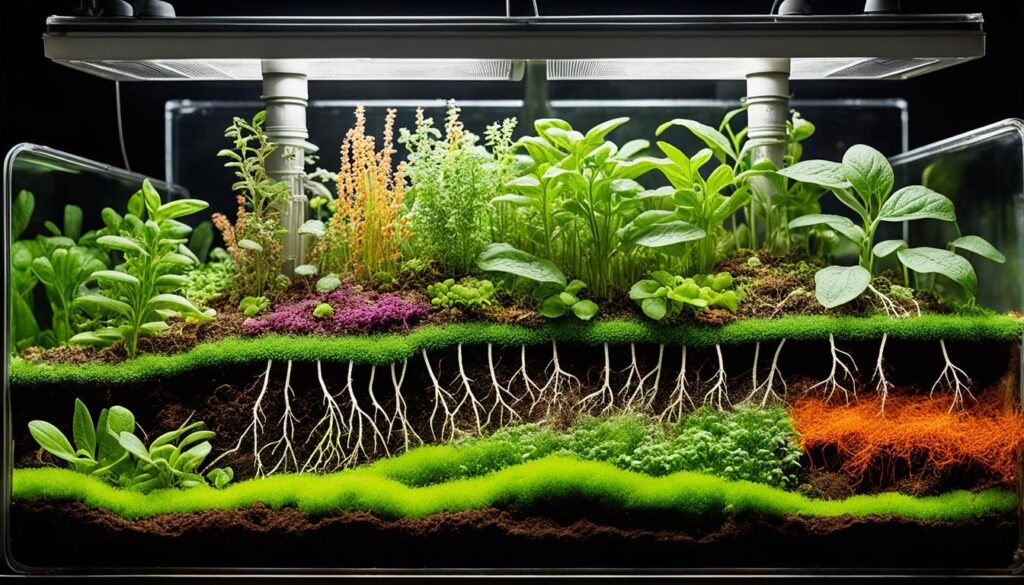
“The soil microbiome is the foundation of a healthy, productive ecosystem. By understanding the role of root exudates, we can unlock the true potential of companion planting to foster a diverse and beneficial microbial community.”
Pest and Disease Management through Companions
Companion planting is a great way to control pests and diseases naturally in your garden. By placing different plants together, you make your garden less welcoming to pests. This means you use fewer chemicals and your garden stays healthier.
Some plants smell bad to pests, keeping them away from your crops. Others hide the look of your plants from pests. And, some plants bring in good bugs like ladybugs that eat the bad bugs.
- Companion planting for pest control can help reduce the reliance on synthetic pesticides.
- Companion plants can emit odors or visually camouflage target crops, making them less appealing to pests.
- Certain companion species can attract beneficial insects that prey on common garden pests.
By mixing different plants together, you make a garden that fights pests and diseases on its own. This method cuts down on harmful chemicals. It also helps your plants and local wildlife thrive together.
| Companion Plant | Pest or Disease Targeted | Mechanism of Action |
|---|---|---|
| Marigolds | Nematodes, aphids, and other garden pests | Marigolds release a compound called thiopene, which acts as a natural pest repellent. |
| Nasturtiums | Aphids, whiteflies, and other sucking insects | Nasturtiums produce a strong scent that can confuse and deter many garden pests. |
| Basil | Tomato hornworms and mosquitoes | Basil’s fragrant leaves can repel tomato hornworms, and the plant’s essential oils also act as a natural mosquito deterrent. |
Using these companion plants for disease resistance helps your garden fight pests naturally. This method is better for your plants and the environment. It makes your garden healthier and more sustainable.
Nutrient Cycling and Soil Enzyme Activities
Companion planting greatly affects nutrient cycling and soil enzyme activities. These are key to soil health. The roots and chemicals from different plants help soil enzymes break down organic matter and release nutrients.
The Impact of Companion Plants
This boosts soil fertility and plant growth. By knowing how nutrient cycling in companion planting, soil enzyme activities, and how companion plants impact soil work together, gardeners can improve their crops. This leads to better productivity and sustainability.
| Nutrient Cycling Indicator | Impact of Companion Plants |
|---|---|
| Soil Enzyme Activity | Increased activity of enzymes involved in organic matter decomposition and nutrient mobilization |
| Nitrogen Cycling | Improved nitrogen fixation and availability through legume companions |
| Phosphorus Cycling | Enhanced solubilization and uptake of inorganic phosphorus |
| Potassium Cycling | Improved mobilization and recycling of potassium from mineral sources |
By using nutrient cycling in companion planting, gardeners and farmers can make their soil better. This leads to healthier plants and more food.
Companion Planting for Drought Resistance
Gardening in dry areas requires plants that can handle drought well. Companion planting is a great way to make gardens more resilient. Some plants have deep roots that help keep soil moist for others.
Companion planting also improves soil health. As different plants grow together, their roots mix and break down, making soil better at holding water. This means your garden can survive with less water.
| Drought-Resistant Companion Plants | Characteristics |
|---|---|
| Lavender (Lavandula spp.) | Deep, drought-tolerant roots that can help improve soil moisture retention |
| Rosemary (Rosmarinus officinalis) | Aromatic herb with a robust root system, thriving in dry conditions |
| Yarrow (Achillea millefolium) | Extensive root system that can help distribute water to neighboring plants |
Adding these drought-resistant plants to your garden makes your plants stronger and helps your soil hold moisture better. A well-planned garden can handle changing weather and water issues well.
Integrating Cover Crops and Green Manures
Improving soil health and nutrient cycling is key for sustainable farming. Using cover crops and green manures can change the game. Cover crops like legumes, grasses, and brassicas help fix nitrogen, fight weeds, and add organic matter to the soil. Green manures, from decomposed plants or compost, boost nutrients and help beneficial soil microbes.
Choosing the right cover crops for your climate and soil is crucial. Legumes, such as clover and alfalfa, take nitrogen from the air for your crops. Grasses, like rye and oats, build soil matter and stop erosion. Brassicas, including mustard and radish, break up hard soil and release nutrients as they decay.
- Try different cover crop mixes to see what works best for you.
- Plan when to plant and add cover crops with your main crops’ needs.
- Use cover crops and green manures together for a nutrient cycle boost.
Adding cover crops and green manures to your planting can unlock your soil’s full potential. It creates a thriving ecosystem that helps your plants grow. This simple method improves soil health and keeps your land productive for years.
| Cover Crop | Benefit |
|---|---|
| Legumes (e.g., clover, alfalfa) | Nitrogen fixation, improve soil fertility |
| Grasses (e.g., rye, oats) | Increase organic matter, prevent soil erosion |
| Brassicas (e.g., mustard, radish) | Break up compacted soil, release nutrients |
“Integrating cover crops and green manures into your companion planting system is a powerful way to enhance soil health and nutrient cycling, ensuring the long-term productivity of your land.”
Conclusion
Companion planting is a great way to make your garden better. By choosing the right plants together, you can make the soil richer and keep it balanced. This method also helps create a garden that is strong and diverse.
It helps with nutrient cycling and fights pests and diseases naturally. This makes it a green and complete way for gardeners to improve their soil and grow a healthy garden.
Adding companion planting to your garden can make it more productive and good for the planet. It makes the soil better, which means your plants will be healthier and taste better. It also helps the good bugs and cuts down on harm to the environment.
If you’re new to gardening or have been doing it for years, trying companion planting can be exciting. It opens up new ways to garden sustainably and makes your garden more lively and full of life.
Using companion planting lets you make the most of your garden. It creates a balanced and self-supporting garden that’s good for you and the earth. Start using companion planting to make your gardening better and greener.
FAQ
What are the benefits of companion planting for soil health?
Companion planting boosts soil fertility and keeps nutrients balanced. It makes your garden more diverse and resilient. It also helps with soil aeration, nutrient uptake, and beneficial microorganisms.
How does companion planting help with nutrient cycling and soil enzyme activities?
Some plants boost soil enzymes that break down organic matter and release nutrients. This makes nutrient cycling better and helps soil fertility and productivity.
Can companion planting help manage pests and diseases naturally?
Yes, it can be a natural way to fight pests and diseases. Some plants release smells or attract insects that keep pests away. Others hide the signs that pests use to find plants.
How can companion planting improve a garden’s resilience to drought conditions?
Some plants have deep roots that help spread and hold moisture in the soil, helping other plants. Also, more soil organic matter and better soil structure from companion planting help soil hold water better. This lessens the effect of drought on your plants.
How can cover crops and green manures be integrated into a companion planting system?
Use cover crops like legumes, grasses, and brassicas to fix nitrogen, control weeds, and add organic matter. Green manures, like compost or decomposed plants, give nutrients and help beneficial microorganisms grow.
Source Links
Top Companion Plant Pairs Every Gardener Should Know
Ever wondered what makes a garden pest-free and thriving? The secret might be in companion planting. But what is it, and how does it boost your gardening success? Learn about the top plant pairs that work together for a harmonious garden.
Key Takeaways
- Companion planting is the strategic pairing of plants that mutually benefit each other
- Certain plant combinations can deter pests, improve soil health, and increase yields
- Knowing the best companion plant pairs can help you create a thriving, low-maintenance garden
- Incorporating flowers and herbs alongside your vegetables can attract pollinators and beneficial insects
- Understanding the science behind companion planting can help you make informed decisions for your garden
What Is Companion Planting?
Companion planting means growing different plants together for mutual benefits. By picking the right plants to grow together, you create a garden that thrives. This method combines ancient farming wisdom with modern science.
Understanding the Benefits of Growing Plants Together
When you practice companion planting, you use the natural strengths of plants. Some plants offer shade or support, while others keep pests away or improve soil. This creates a garden that helps each plant grow better.
- Increased pest resistance through natural pest deterrents
- Enhanced soil fertility from nitrogen-fixing plants or those that attract beneficial insects
- Improved pollination from nectar-rich flowers that attract pollinators
- Greater overall plant health and productivity
Proven Examples of Successful Companion Planting
The Three Sisters method, with corn, beans, and squash, is a classic example. Corn supports the beans, beans enrich the soil, and squash keeps weeds down. This trio shows how plants can work together well.
“Companion planting is nature’s way of minimizing pest damage, boosting soil fertility, reducing weed competition, and, ultimately, increasing yields.”
Evidence-Based Companion Planting Philosophy
Companion planting has grown a lot in recent years. It’s moved from old stories to solid science. Now, thanks to scientific companion planting research, we know which plants work well together.
Before, people thought some veggies had special friends and enemies. But new studies have shown this isn’t always true. They’ve dispelled companion planting myths. Now, we see how plants help each other when grown together.
“The bottom line is that there is simply more evidence for ‘good’ companions than ‘bad’ ones, so the focus is now more on why vegetables need friends.”
Studies show that most plant pairs help each other out. They improve pest control, make nutrients available, and attract pollinators. This proves the benefits of choosing the right evidence-backed plant pairings.
With this evidence-based companion planting philosophy, gardeners can plan their gardens with confidence. They know their plants will grow well together. It’s an exciting time for gardening!
Examples of the Best Companion Plants
Companion planting can greatly benefit your garden. It helps with pest control, plant health, and flavor. Let’s look at some top pairings for your garden.
Basil and Tomatoes: A Classic Combo
Basil and tomatoes are perfect together. Basil keeps away thrips and moths that harm tomatoes. It also brings in bees, which helps pollinate and taste better.
Dill: Attracting Ladybugs to Control Pests
Dill is great for attracting ladybugs. These bugs eat pests like aphids and spider mites. Adding dill near your veggies uses these helpful insects to protect your plants.
Other great beneficial plant pairings include:
- Borage goes well with tomatoes, drawing in bees and making strawberries taste and grow better.
- Garlic and garlic spray keep pests away with their strong smell.
- Mint keeps aphids, ants, and flea beetles away, making it a top choice for pest control.
- Nasturtiums draw caterpillars away from cabbage, broccoli, and kale.
- Parsley brings in beneficial insects to protect and pollinate tomatoes.
Using these successful companion planting examples in your garden creates a healthy, balanced environment. Your plants will thrive and be more productive.
The Science Behind Companion Planting
The study of companion planting is a deep dive into how plants interact with insects and each other. Scientists have found out why some plants work well together. They’ve uncovered the secrets of nature’s clever designs.
Take radishes and pumpkins, for example. When grown together, radishes keep away the squash bug from pumpkins. This happens because radishes release chemicals that pumpkins can absorb. These chemicals protect pumpkins from pests.
Tomatoes and basil are another great pair. Basil’s scent hides the tomatoes from pests. This shows how plants can work together using chemistry.
Leaf shape and arrangement matter too. A mix of leaves can confuse pests, making it hard for them to find their target plant. This helps protect the plant from being eaten.
| Companion Plant Pairing | Scientific Explanation |
|---|---|
| Radishes and Pumpkins | Radishes secrete water-soluble glucosinolates that can be absorbed by pumpkin plants, providing them with natural pest deterrence. |
| Tomatoes and Basil | Basil’s strong aroma helps to disguise the presence of tomato plants, making it harder for pests to locate their desired target. |
| Diverse Leaf Arrangements | A confusing array of leaves can effectively conceal a plant from its would-be predators, as pests may struggle to recognize their host amidst the melee of foliage. |
Studies on companion planting, plant-insect relationships, and plant biochemistry and pest deterrence have given us new insights. They show how plants can help each other grow strong and pest-free. By using these principles, gardeners can create gardens that are full of life and pests.
top companion plant pairs
Companion planting is key to a successful garden. By pairing certain plants, you create a balanced garden. This helps both your veggies and flowers grow well. Let’s look at some top pairings every gardener should know.
Vegetables and Herbs: Tried-and-True Combinations
Basil and tomatoes make a classic pair. Basil improves tomato flavor and keeps pests away. Dill and cucumbers are another great pair. Dill attracts ladybugs that eat aphids, keeping cucumbers healthy.
Flowers and Pollinators: A Mutually Beneficial Relationship
Adding flowers to your garden attracts pollinators and boosts plant health. Flowers like zinnias, cosmos, and marigolds draw bees and butterflies. This flower-pollinator companion plant relationship helps pollinate your veggies and makes your garden lively.
“Companion planting is a time-honored tradition that can transform your garden into a thriving, self-sustaining oasis.”
Common Mistakes in Companion Planting
Companion planting can change the game in the garden, but it has its challenges. Both new and seasoned gardeners need to watch out for common companion planting pitfalls. One big mistake is not thinking about how plants grow. Planting tall crops near short ones can block sunlight and compete for resources.
Another mistake is pairing incompatible plant combinations. Some plants do well together, but others can harm each other. For example, some plants release chemicals that stop nearby plants from growing well.
- Failing to keep plants at the right distance from each other
- Mixing plants with different water and nutrient needs
- Not checking which plants are good “companions”
“The key to successful companion planting is understanding the unique growth habits and requirements of each plant species you wish to grow together.”
By looking into successful plant pairings and considering plant growth habits, gardeners can dodge common mistakes. This way, they can enjoy the benefits of this rewarding gardening method.
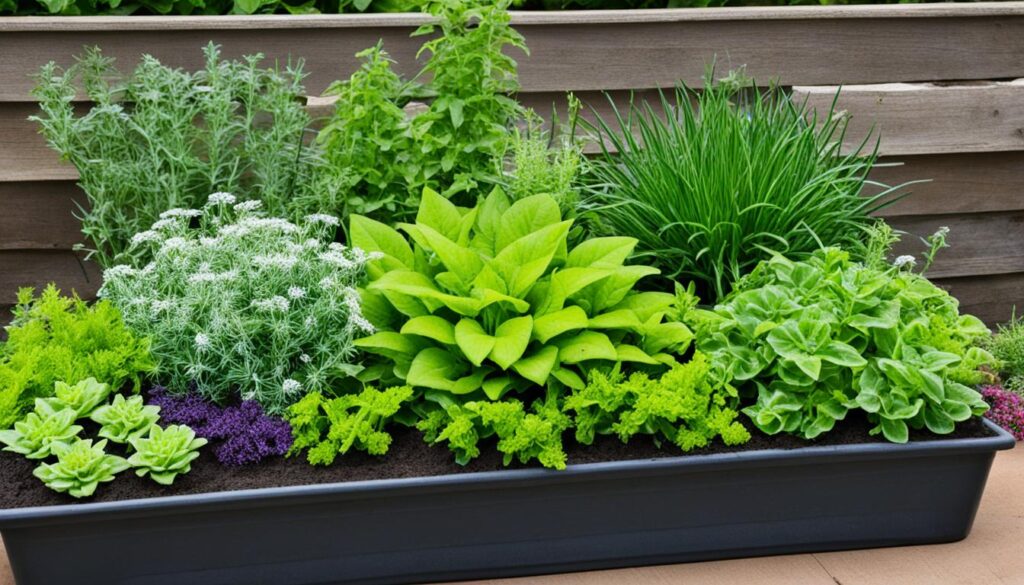
Companion Planting for Pest and Disease Control
Companion planting is a natural way to fight pests and diseases in your garden. Many herbs and flowers have scents or properties that keep pests away. They also draw in beneficial insects that eat pests.
Using Herbs to Repel Pests and Attract Beneficials
Herbs like garlic, mint, and marigolds have strong smells that pests don’t like. Planting these near your veggies can keep pests away. This helps protect your plants.
Some herbs and flowers also bring in good bugs that eat pests. For instance, dill and borage attract ladybugs and other insects that eat aphids and other pests.
| Herb | Pest Repellent | Beneficial Insect Attractor |
|---|---|---|
| Garlic | Aphids, beetles, rodents | – |
| Mint | Aphids, ants, cabbage worms | – |
| Marigolds | Nematodes, aphids, beetles | – |
| Dill | – | Ladybugs, lacewings |
| Borage | – | Bees, lacewings |
By adding these companion plants for pest management to your garden, you make a balanced ecosystem. This approach naturally keeps pests away and brings in beneficial insects. It makes your garden healthier and more sustainable.
“Companion planting is all about creating a diverse, self-sustaining garden ecosystem that works in harmony to control pests and diseases naturally.”
Incorporating Flowers into Your Vegetable Garden
Adding flowers as companion plants to your vegetable garden brings many benefits. They make your garden look great and help keep pests away. Pollinator-attracting flowers like nasturtiums, marigolds, and zinnias draw in good insects that eat garden pests.
When picking flowers for companion planting, think about when they bloom, how much sun and water they need, and how big they get. This way, your flowers and vegetables will work well together. They’ll make your garden a healthy, diverse place.
Flowers for Pest Control and Pollination
- Marigolds keep pests like aphids, nematodes, and rabbits away. They’re a great ornamental for pest control.
- Nasturtiums draw in ladybugs and lacewings. These insects eat aphids and other pests.
- Zinnias are easy to care for and pollinators love them. They help pollinate your vegetables.
By adding different kinds of pollinator-attracting flowers to your garden, you make a great place for your plants and local wildlife.
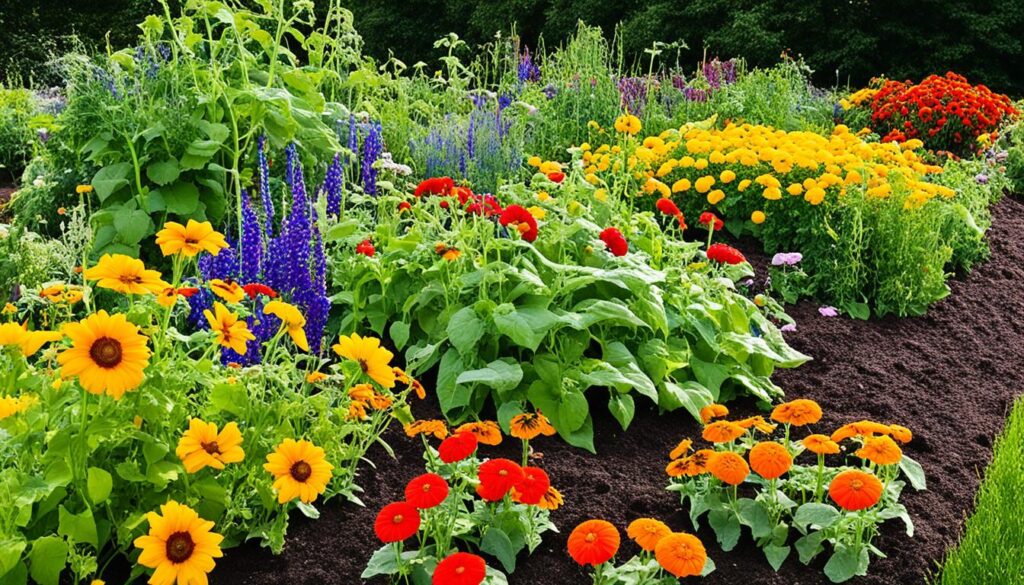
“A well-designed flower border can be both beautiful and functional, providing valuable habitat and resources for beneficial insects while enhancing the overall health and productivity of your vegetable garden.”
Bad Neighbors: Plants to Avoid Planting Together
Companion planting pairs plants to work well together in the garden. But, some plants don’t get along and should be kept apart. Knowing which plants clash is key to a healthy garden.
One big reason to keep some plants apart is they compete for things like nutrients and sunlight. Plants that fight over these resources shouldn’t be planted together. For instance, zucchini and winter squash vines can overshadow lettuce, making it hard for the lettuce to grow.
It’s also smart to keep plants that get the same diseases apart. This stops one sick plant from spreading its illness to others. So, tomatoes and potatoes shouldn’t be side by side since they can both get the same fungal diseases.
| Incompatible Plant Combinations | Reason for Avoiding |
|---|---|
| Zucchini or Winter Squash vs. Lettuce | Competition for resources (nutrients, water, space, sunlight) |
| Tomatoes vs. Potatoes | Susceptibility to the same diseases (e.g., fungal infections) |
| Brassicas (Cabbage, Broccoli, Cauliflower) vs. Tomatoes | Allelopathic effects (release of chemicals that inhibit growth of other plants) |
By knowing which plants don’t mix well, gardeners can grow a garden that’s full of life and productivity. This way, they make the most of planting together while avoiding problems with plant relationships.
Conclusion
Companion planting is a key gardening method that makes your garden better. It pairs plants together to keep pests away, improve soil, and draw in helpful insects. This approach boosts your garden’s productivity and looks.
It doesn’t matter if you’re growing veggies, herbs, or flowers. Using companion planting leads to more food and a healthier garden. You can try pairing basil with tomatoes or find new ones to see what works best.
Every garden is different, so try out various plant combinations. Watch how they interact and change things as needed. With a diverse garden, you get a space that’s easy to care for and supports both you and local wildlife.
FAQ
What is companion planting?
Companion planting means growing plants together that help each other out. This method stops diseases, keeps pests away, and gives shade to other plants. It makes your garden healthier and more productive.
What are the benefits of companion planting?
It cuts down on pesticides, draws in pollinators, enriches the soil, and boosts your harvest. It’s a smart way to build a garden that’s full of life and needs less care.
What are some examples of successful companion plant pairings?
Great pairs include basil with tomatoes, dill with ladybugs, and borage with strawberries. Zinnias, cosmos, and marigolds also attract good bugs to your veggies.
Is there scientific evidence to support companion planting?
Yes, studies show that certain plants grow better together. They can fight pests, grow faster, and help wildlife. We’re learning more about how plants help each other out.
What are some common mistakes to avoid in companion planting?
Don’t pick plants with big roots that might compete, plant them too close, or ignore how they grow. Make sure to check which plants work well together before you start your garden.
How can companion planting help with pest and disease control?
Herbs like garlic, mint, and marigolds keep pests away with their strong smells. Planting them with veggies helps control pests. Some plants, like dill and borage, bring in good bugs that fight pests and boost crops.
What are some good flower choices for companion planting?
Flowers such as nasturtiums, marigolds, and zinnias keep pests away and draw in helpful insects. Pick flowers that match your veggies in sun, water, and growth needs for the best results.
Which plants should not be planted together?
Don’t plant plants that fight over resources like nutrients, water, space, and sunlight. Keep plants that get the same diseases apart to stop disease from spreading.
Source Links
- 10 Must-Have Blooms for Your 2025 Garden
- The Health Advantages of Gardening You Need to Know
- How to Create a Small Vegetable Garden Layout Plan: A Beginner’s Guide
- DIY Garden Projects for Small Spaces: Upcycling Ideas to Maximize Your Garden
- Watering Techniques for Small Gardens: Ensuring Your Plants Thrive
- Small Border Plants for Landscaping: Adding Beauty and Functionality to Your Garden
- Year-Round Small Space Gardening: Seasonal Planting Tips for Maximum Harvest
- Essential Tools for Small-Space Gardening: What You Really Need
- The Ultimate Guide to Container Vegetables: What to Grow in Small Spaces
- Budget-Friendly Gardening: How to Create a Thriving Garden on a Tight Budget
- How to Optimize Sunlight in Small Gardens: Tips for Better Plant Growth
- DIY Vertical Planters: Creative Ideas for Small Space Gardening
- Companion Planting for Small Vegetable Gardens: Boost Growth and Deter Pests
- Container Gardening Essentials: Choosing the Right Pots, Soil, and Plants
- Vertical Gardening Techniques: Maximizing Your Small Space with Climbers and Vines
- How to Build a Raised Bed Garden in a Small Backyard: Step-by-Step Guide
- The Best Vegetables for Small-Space Gardens: High-Yield Varieties You Need to Grow
- Smart Vegetable Garden Layouts for Small Spaces: Maximizing Your Green Thumb in Compact Areas
- 40. Best Practices for Managing a Sustainable Garden Year-Round
- Building a Wildlife Pond for Biodiversity
- Advanced Techniques in Sustainable Gardening
- How to Create a No-Till Garden
- The Mental Health Benefits of Gardening
- Using Technology to Enhance Sustainable Gardening
- Getting Certified Organic: Steps and Benefits

